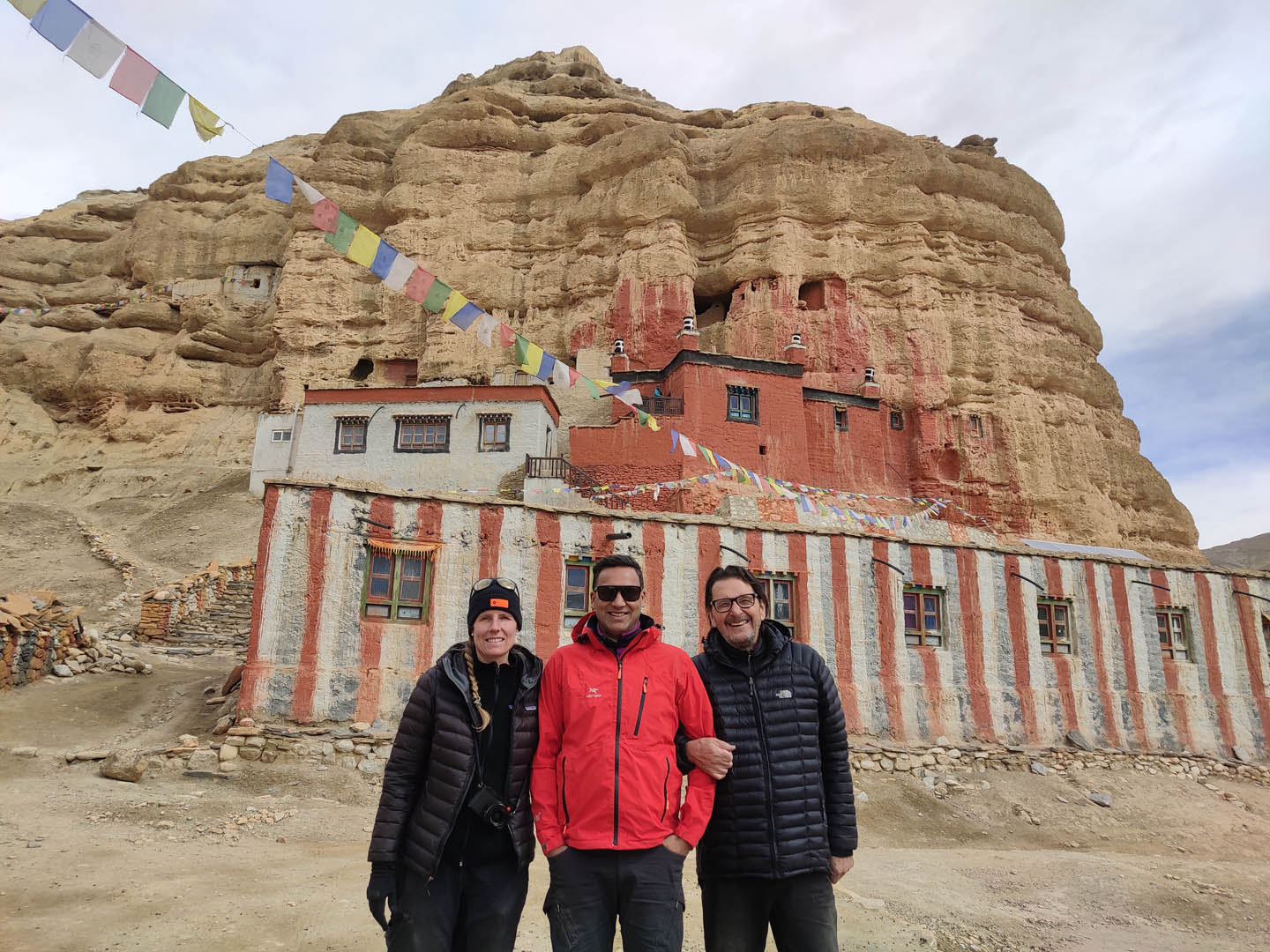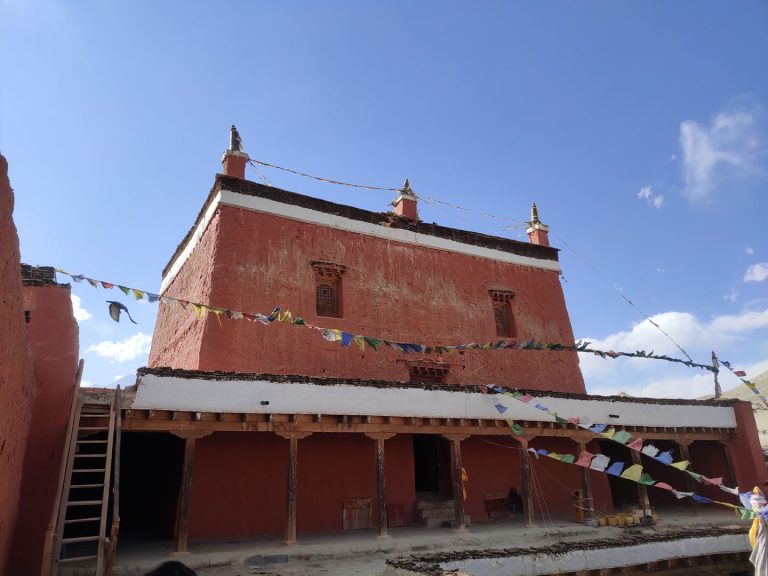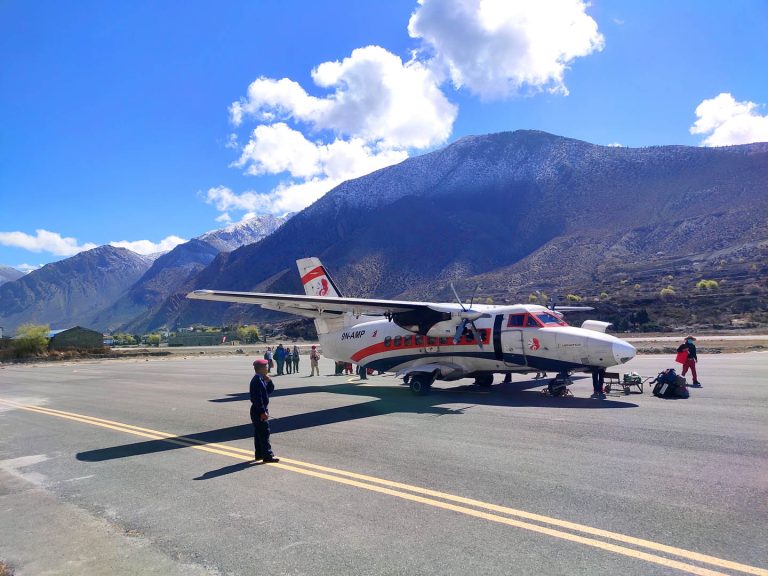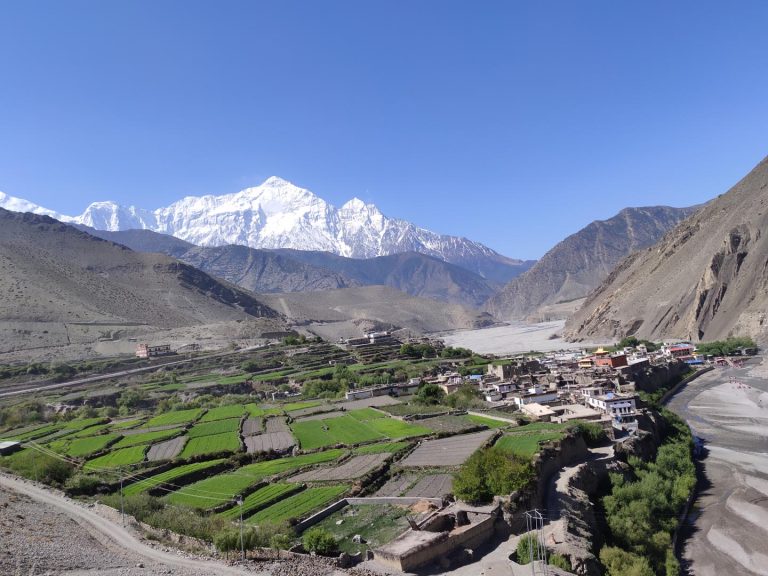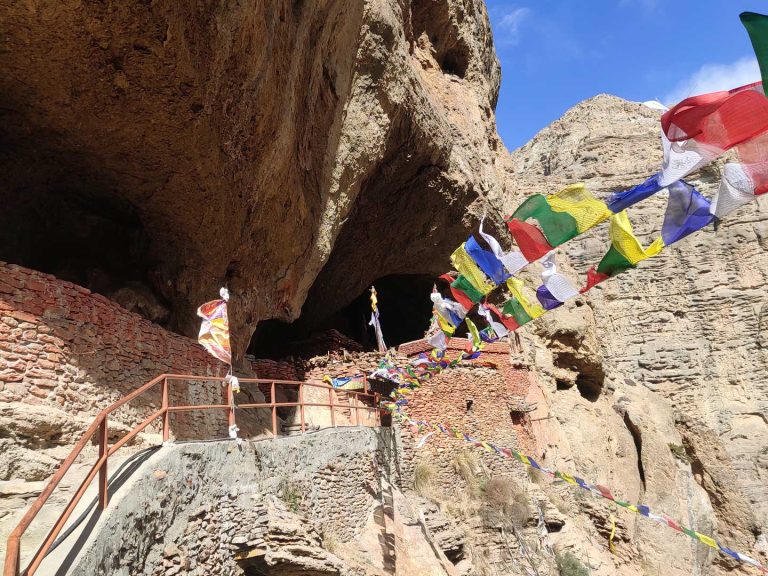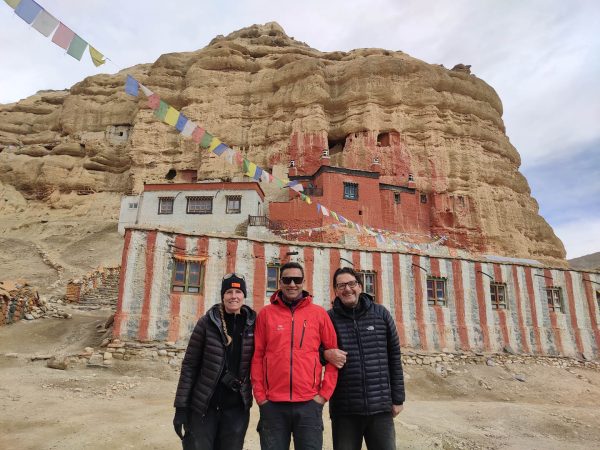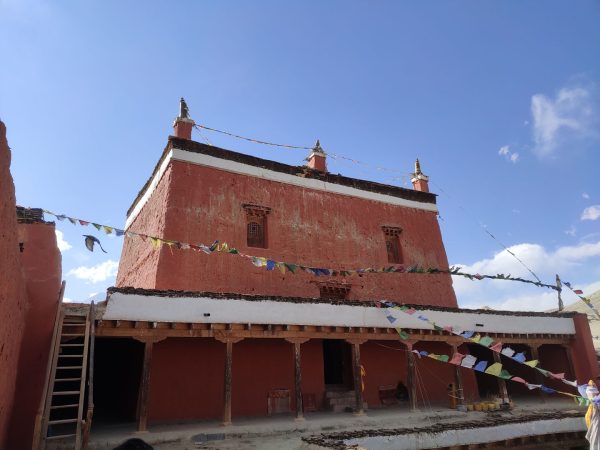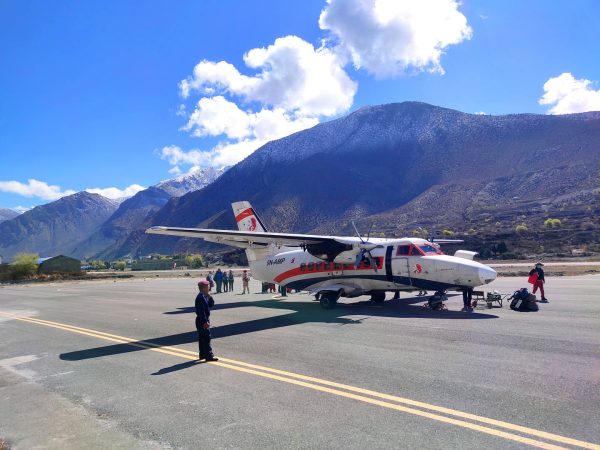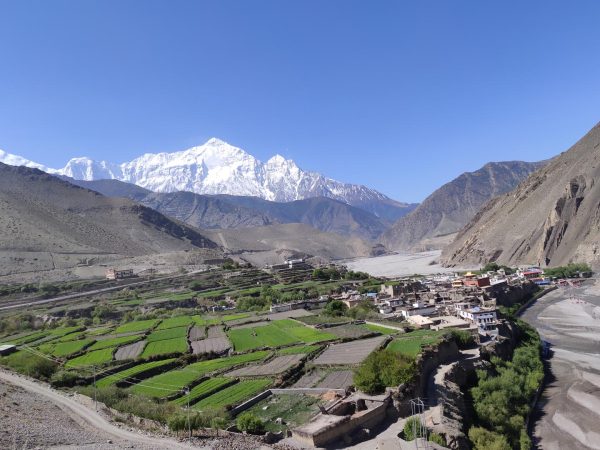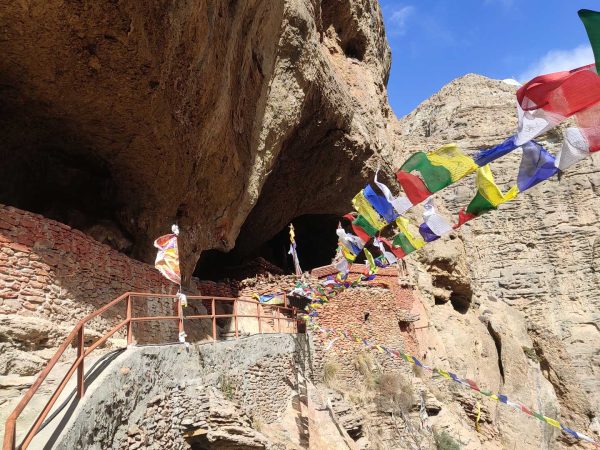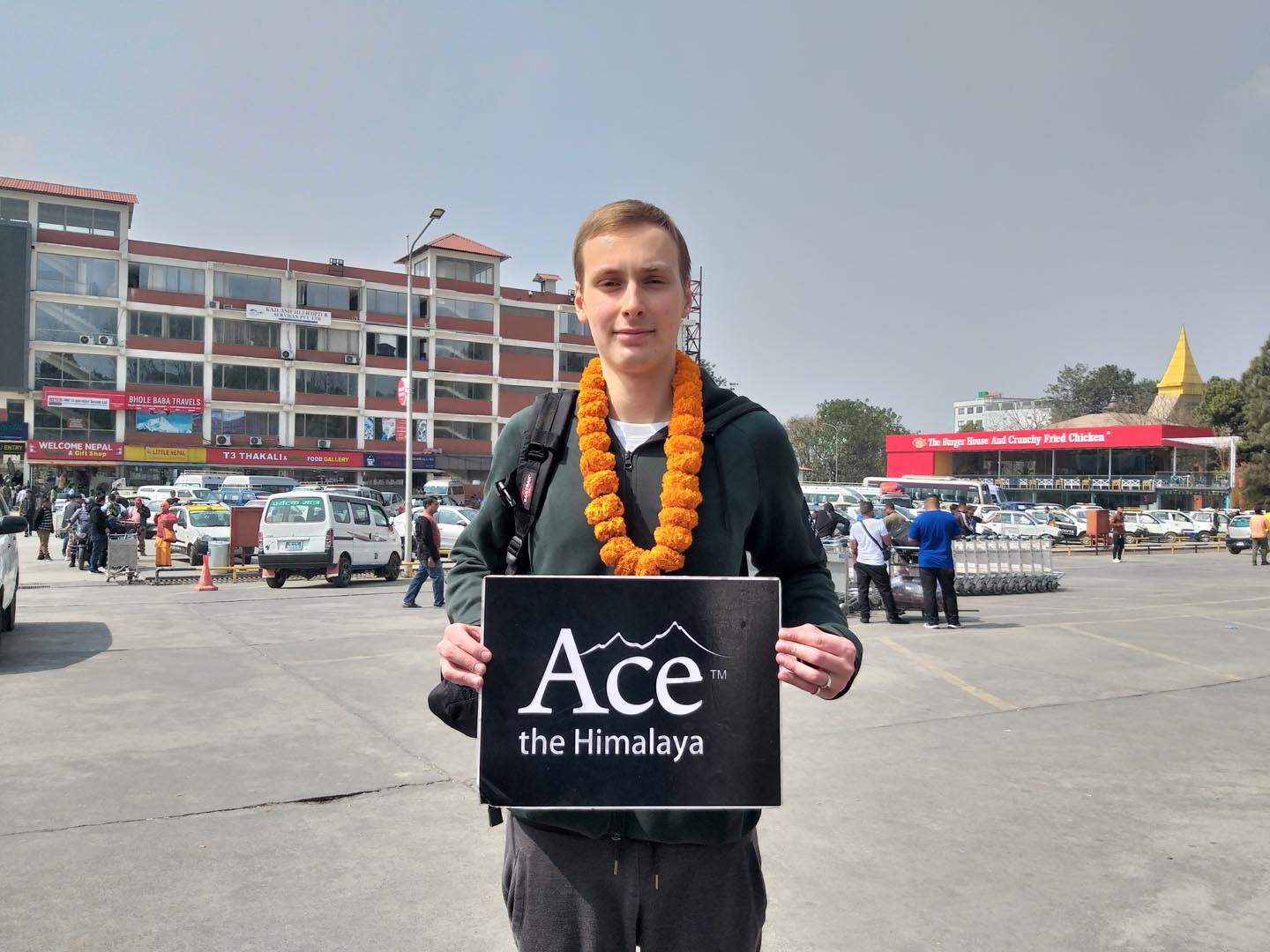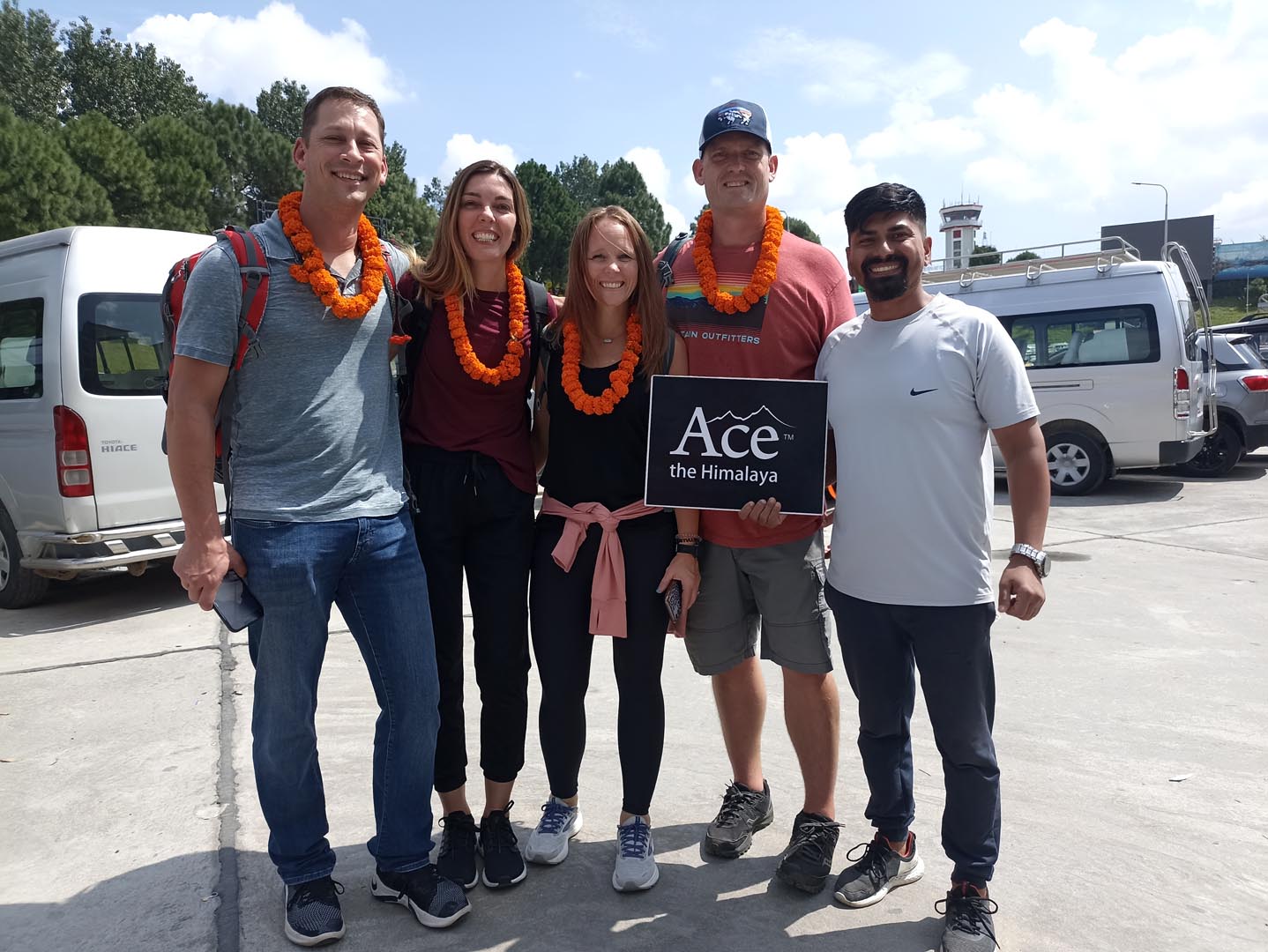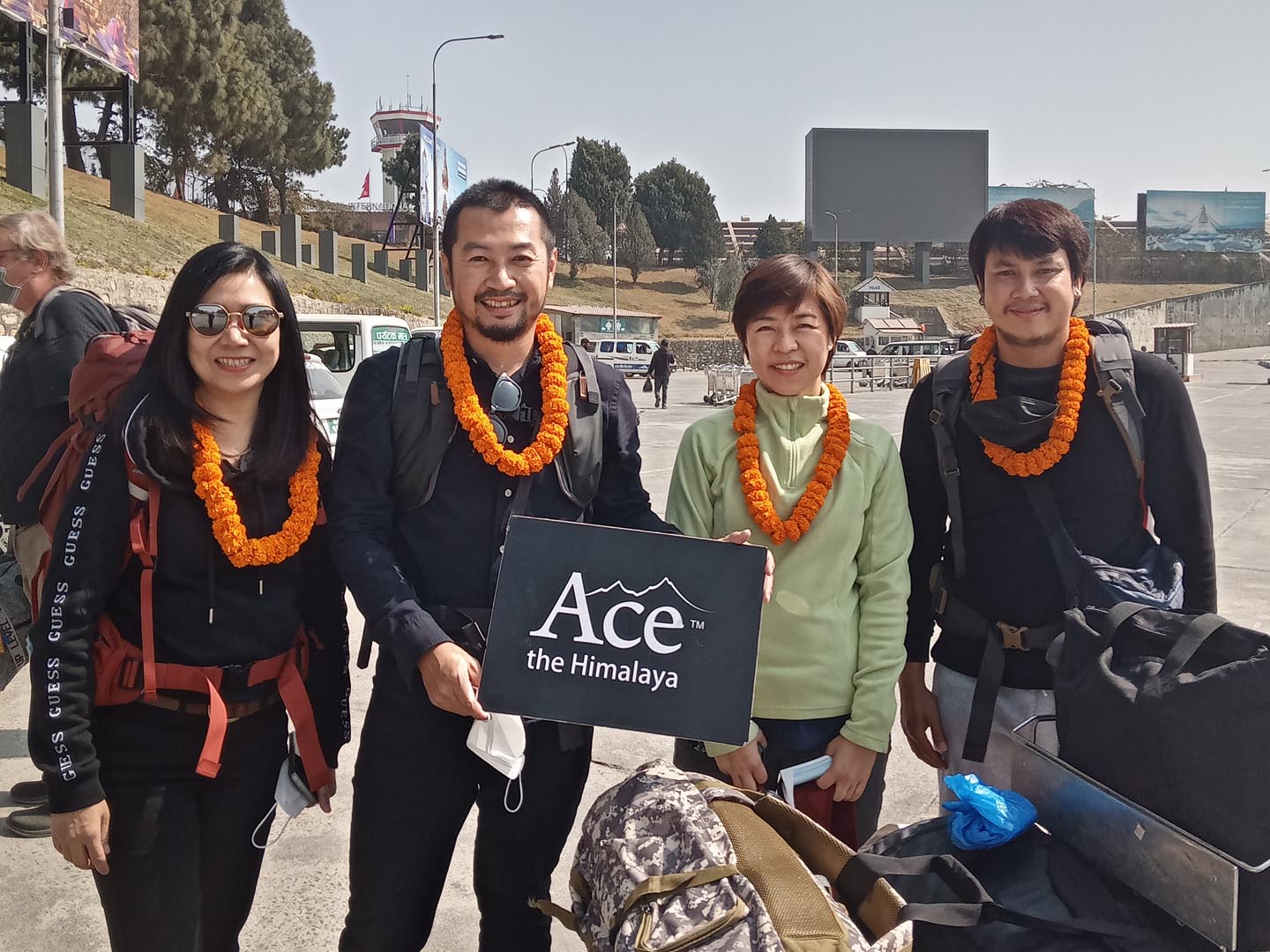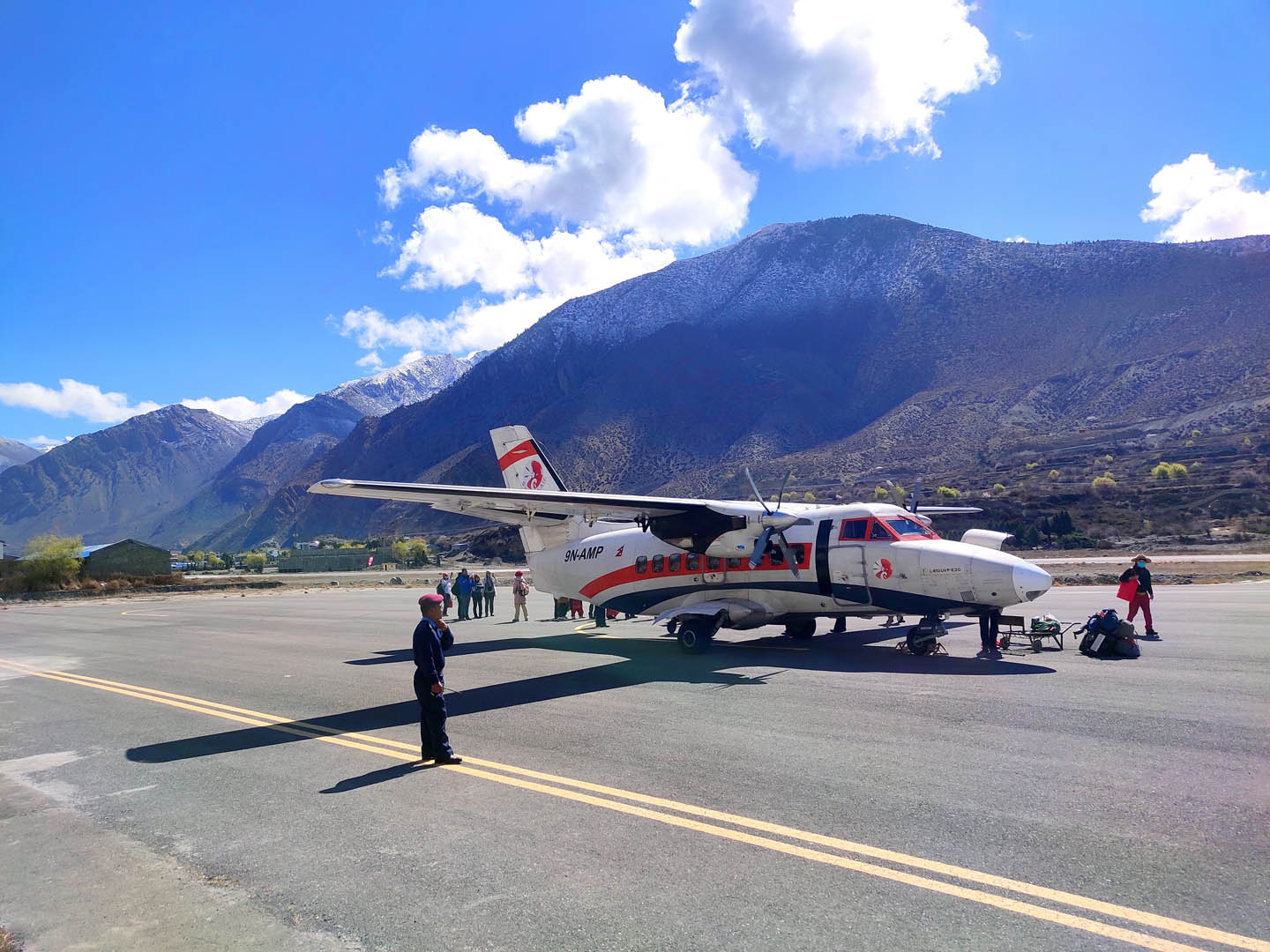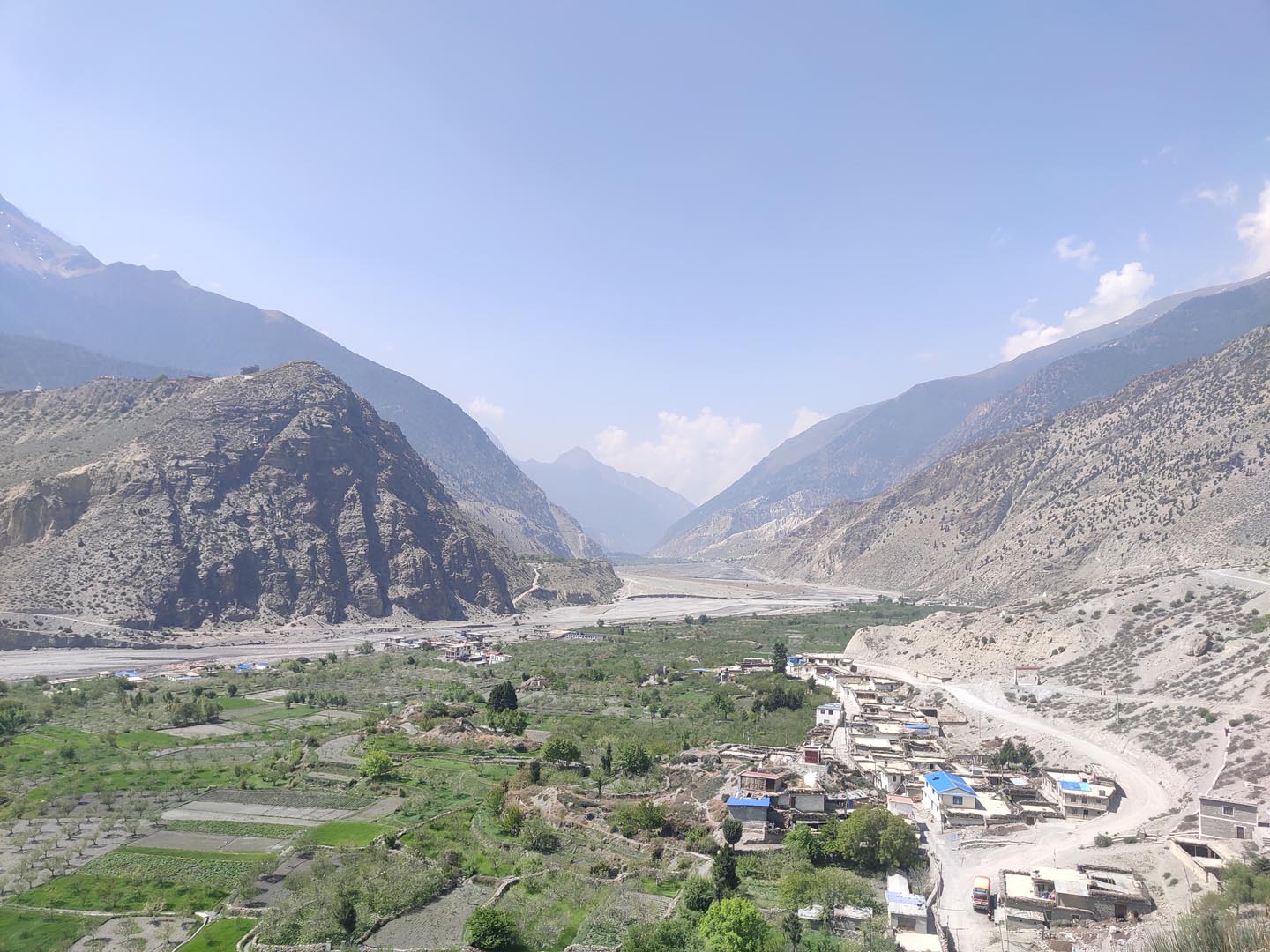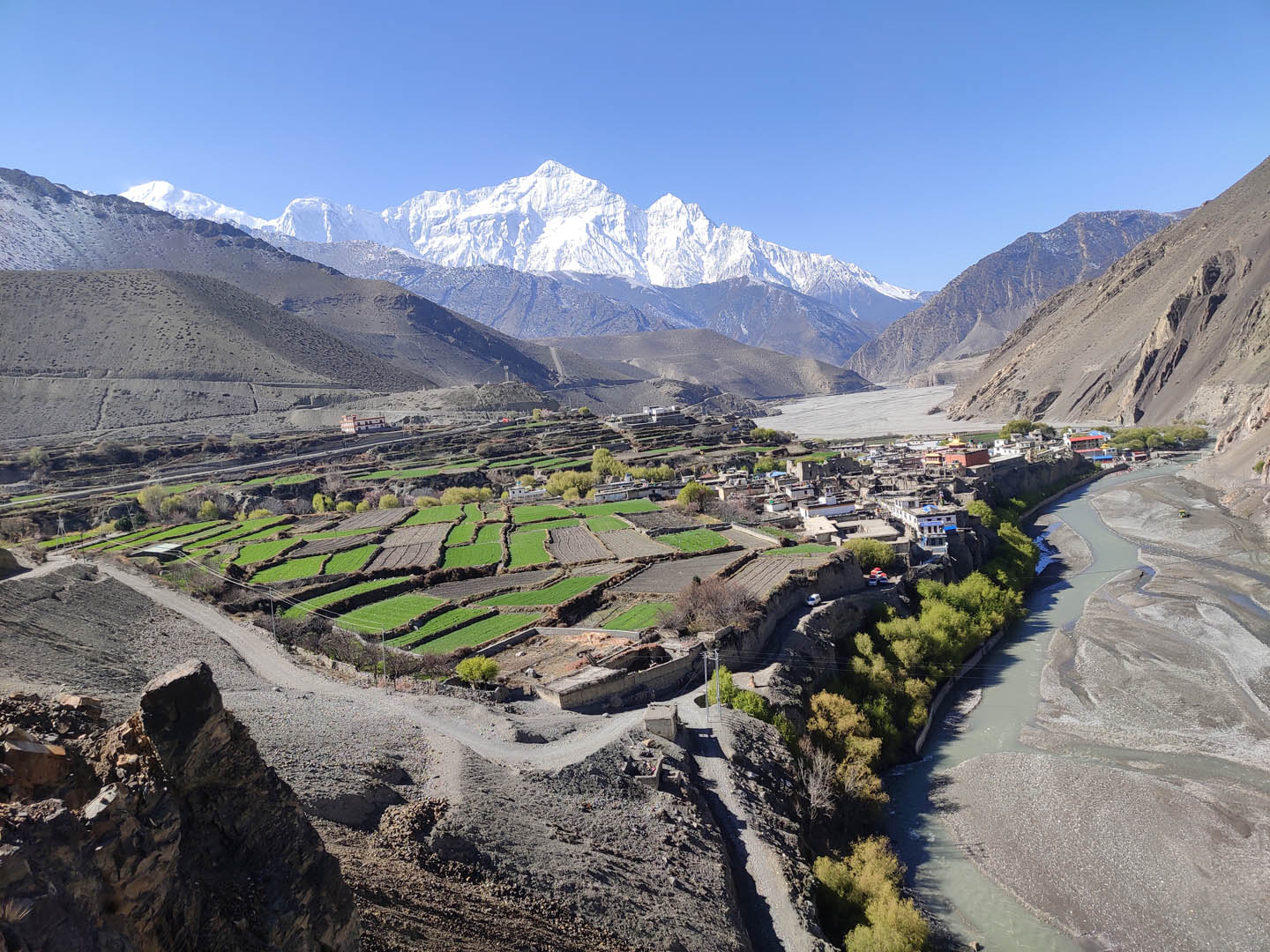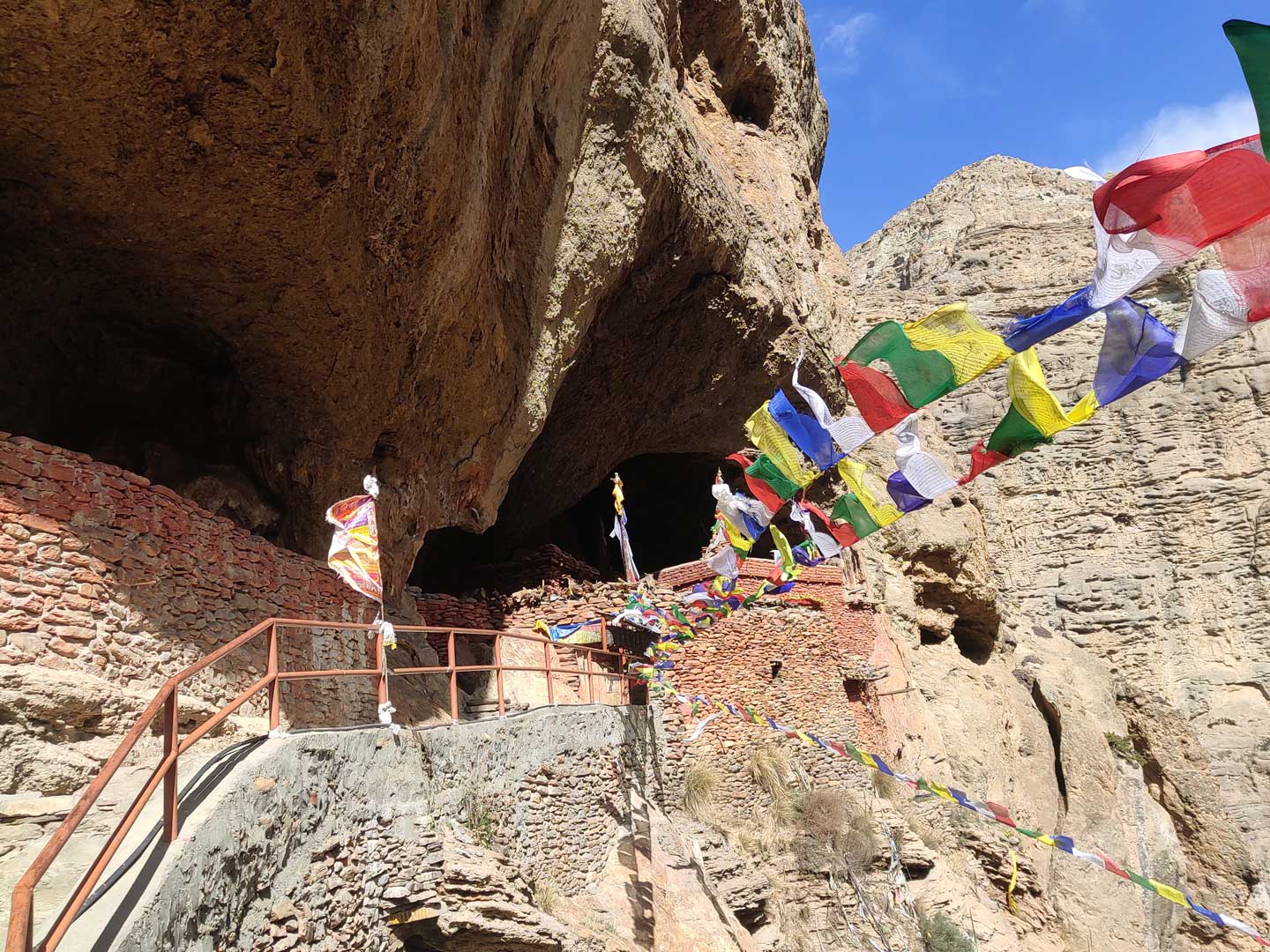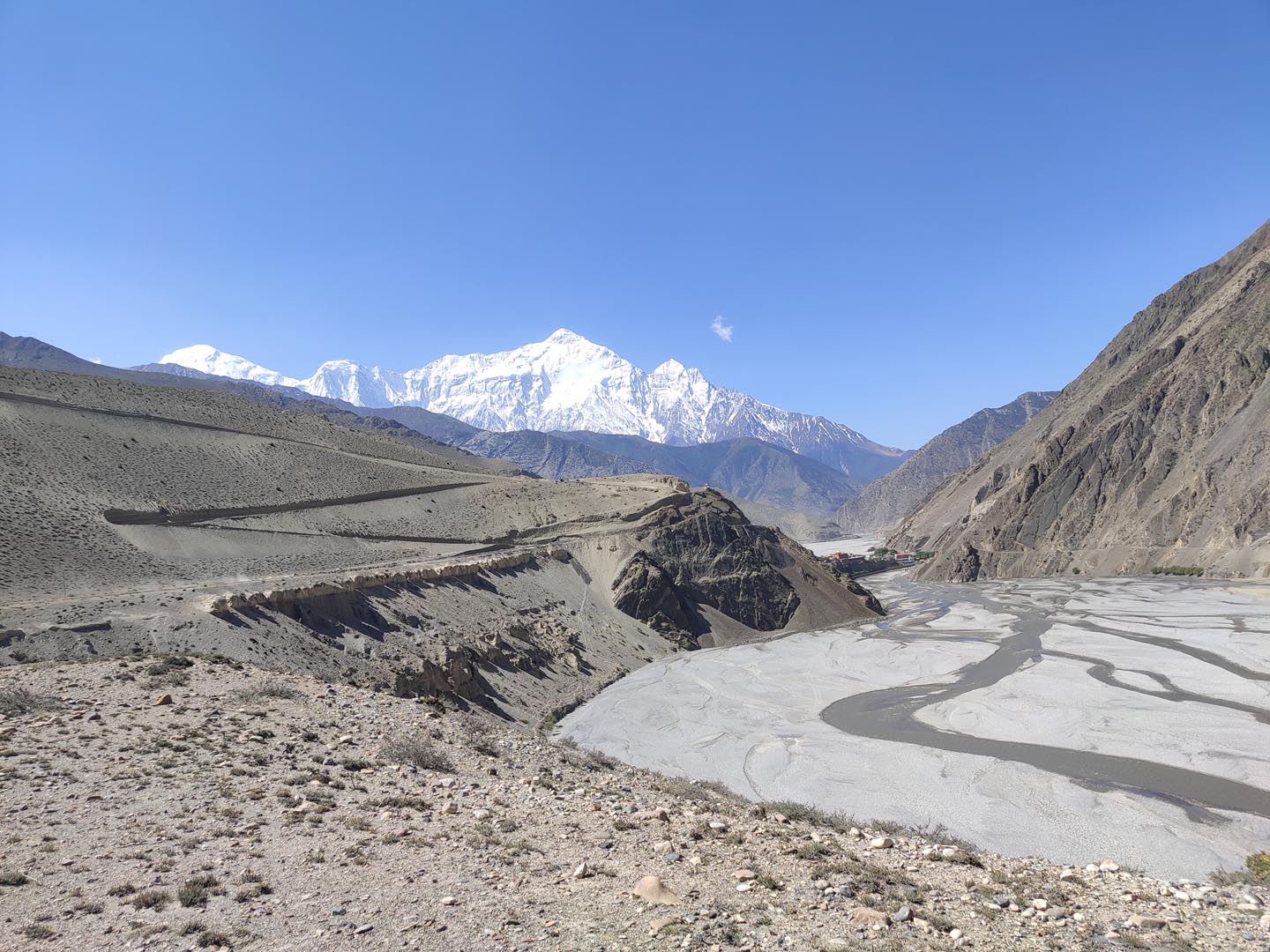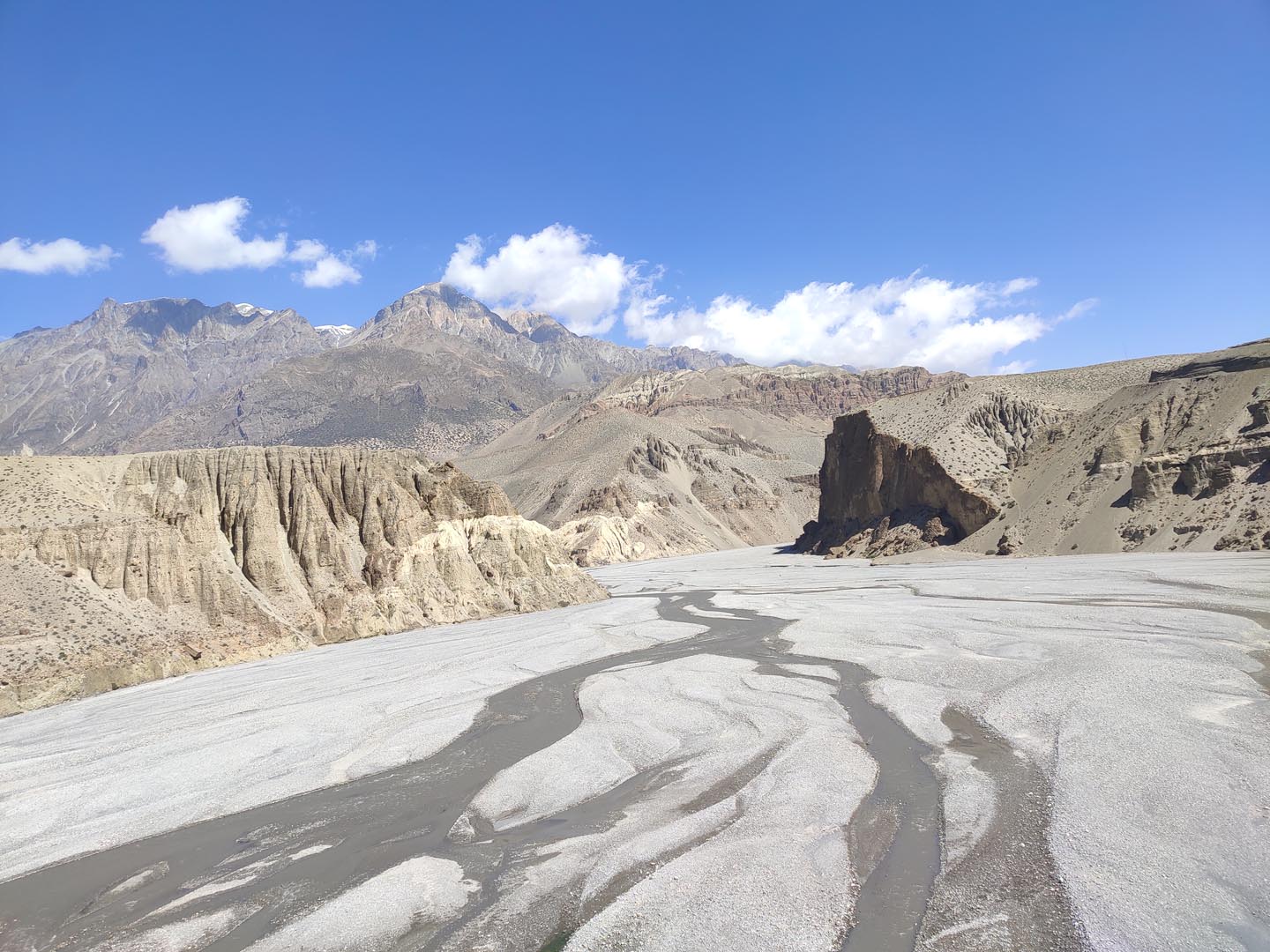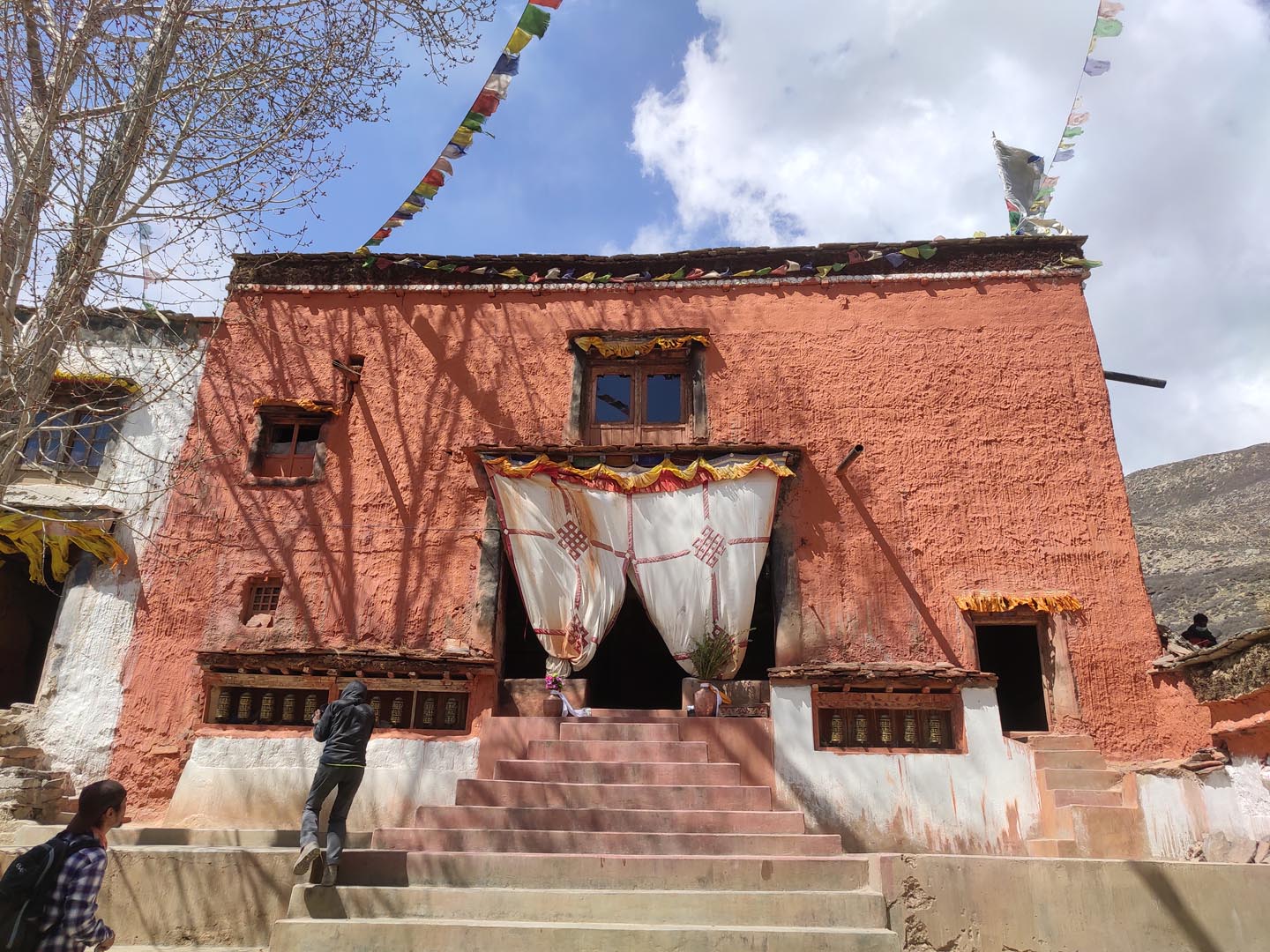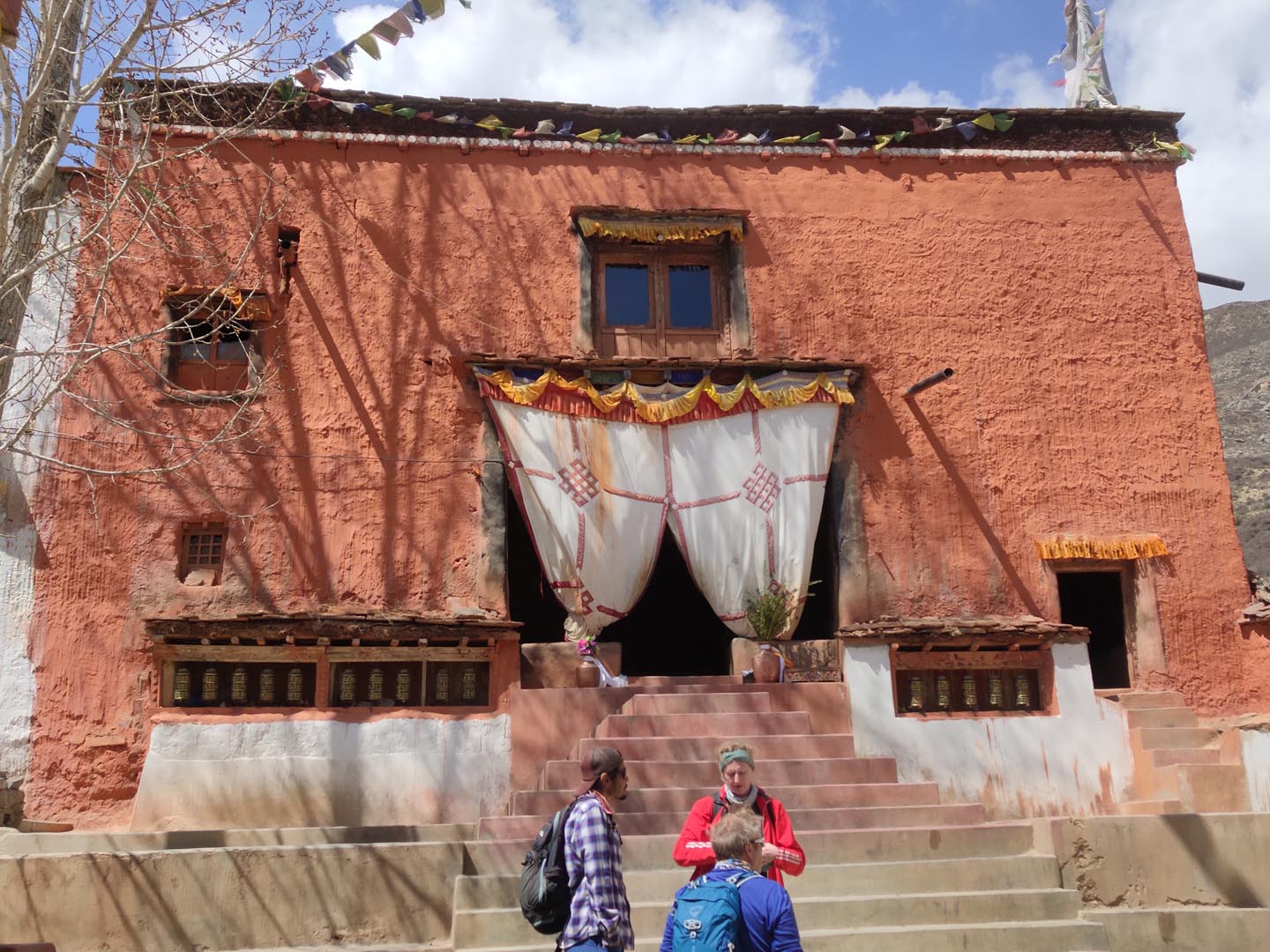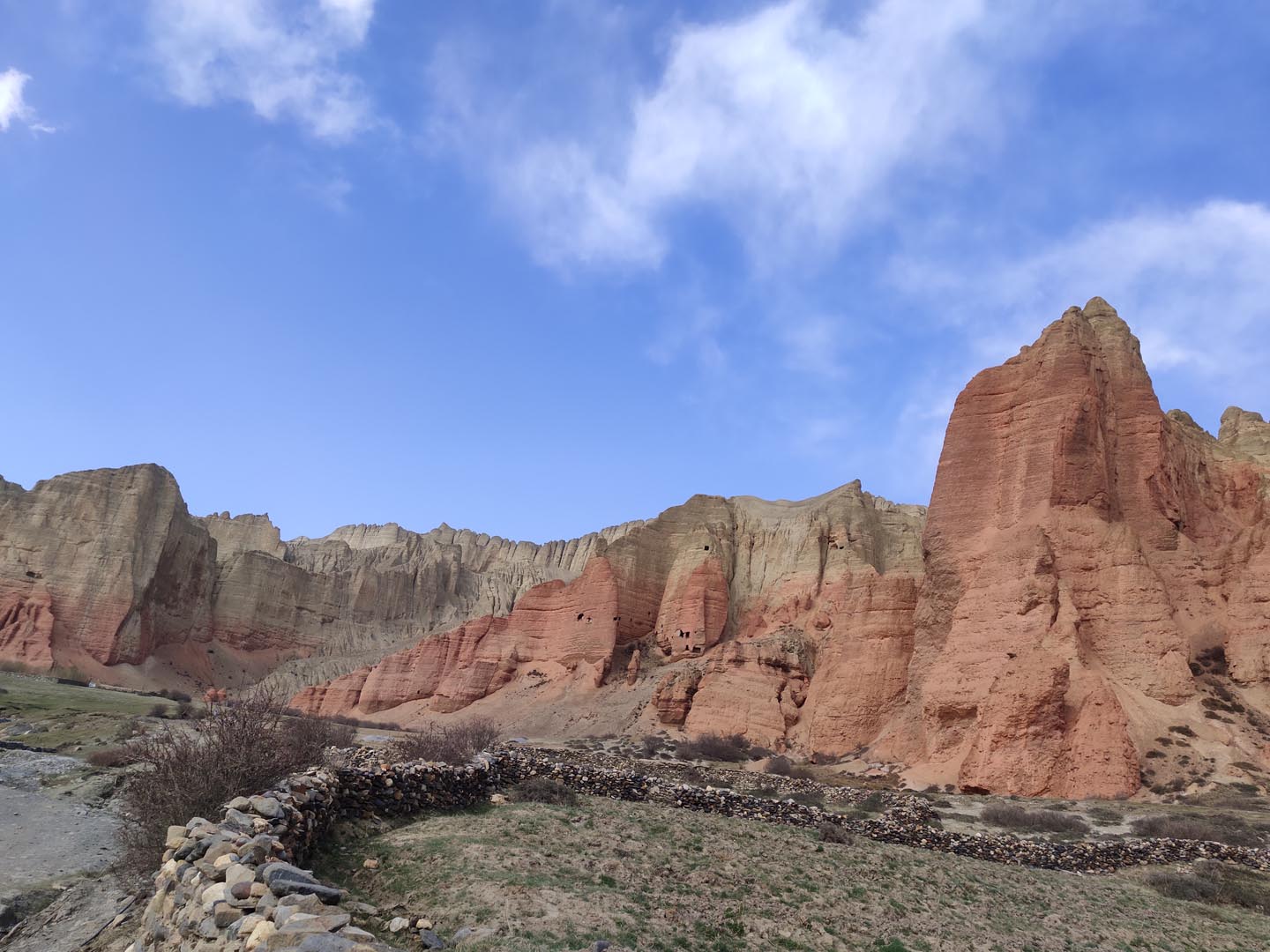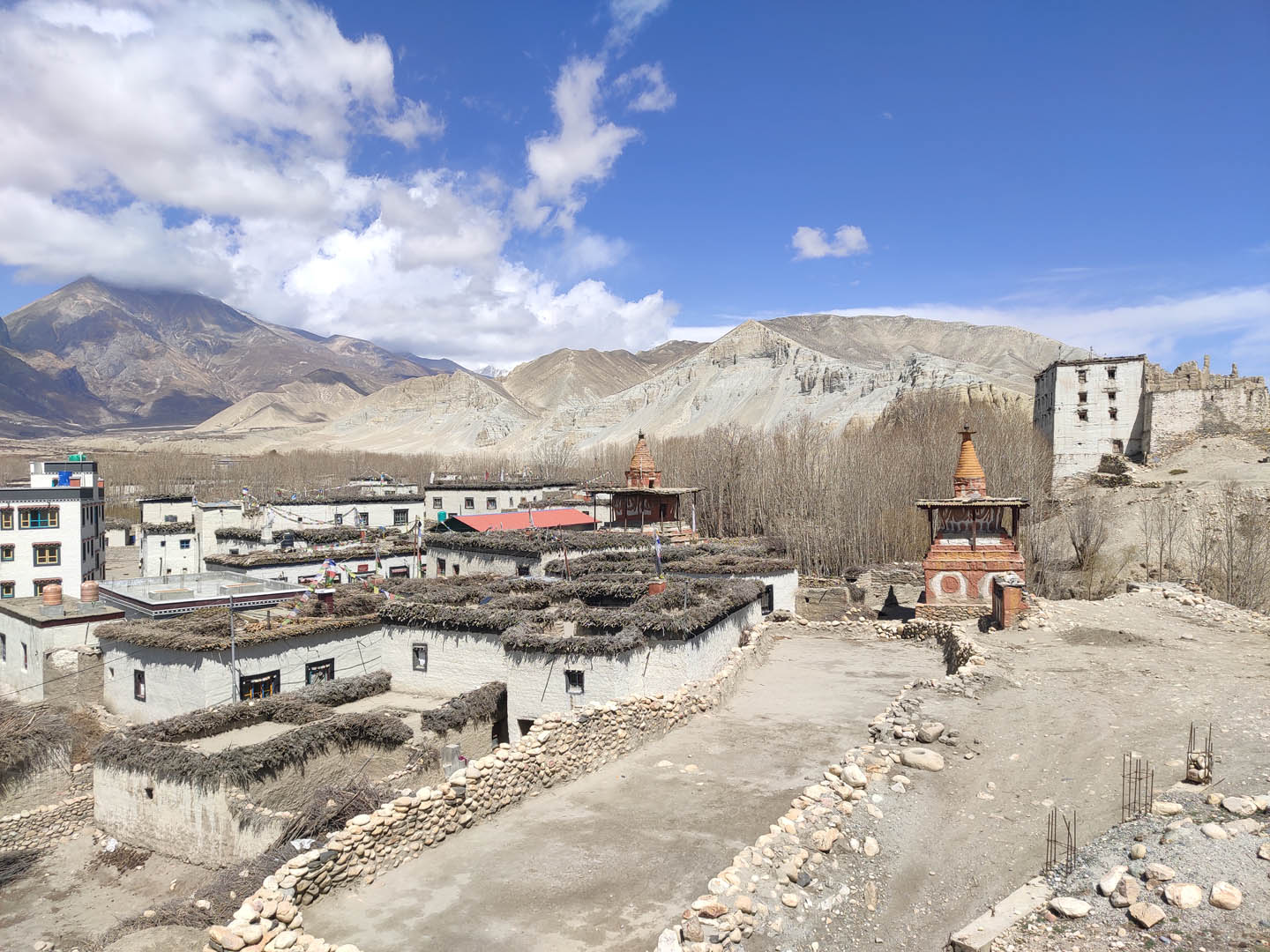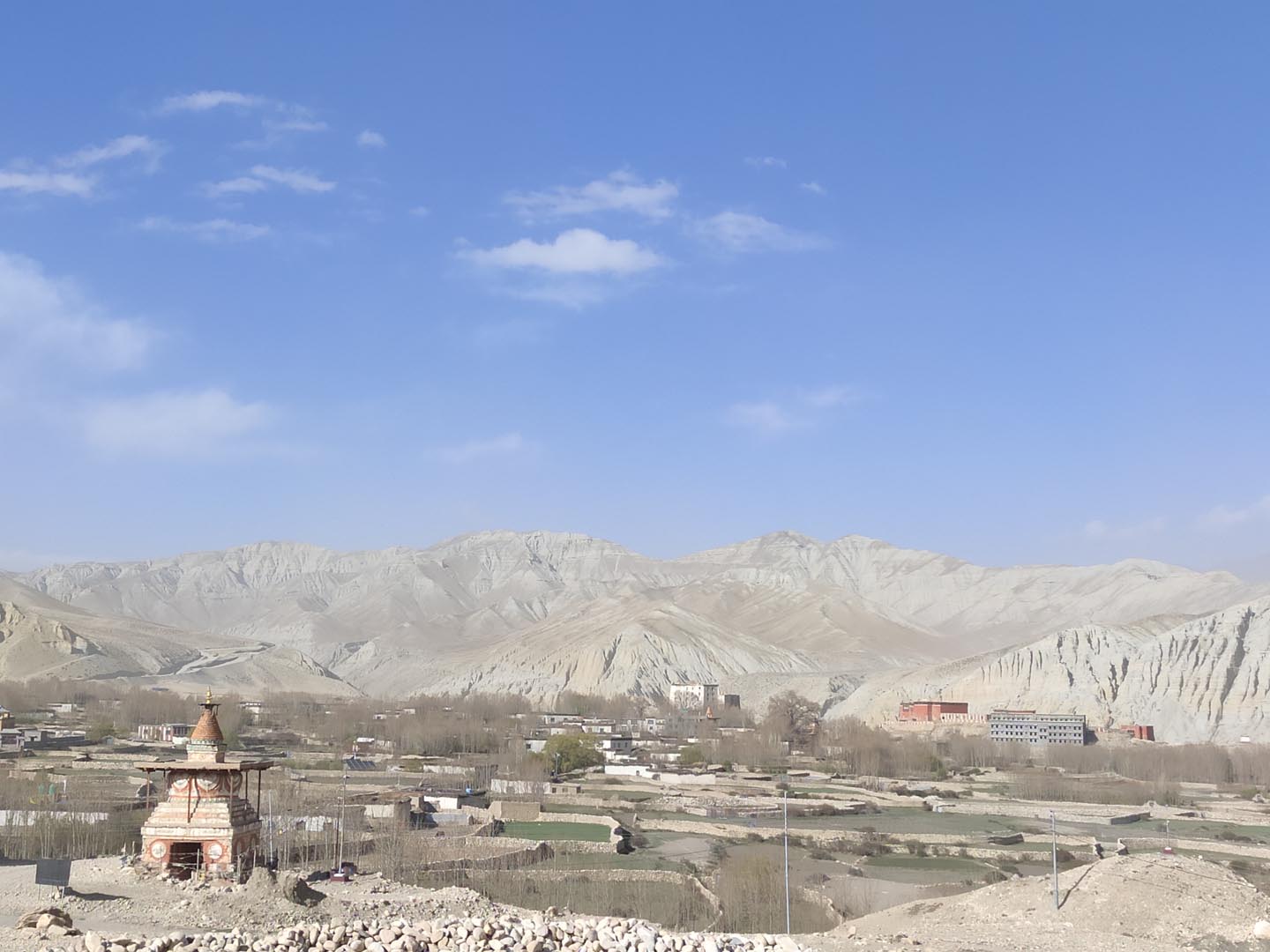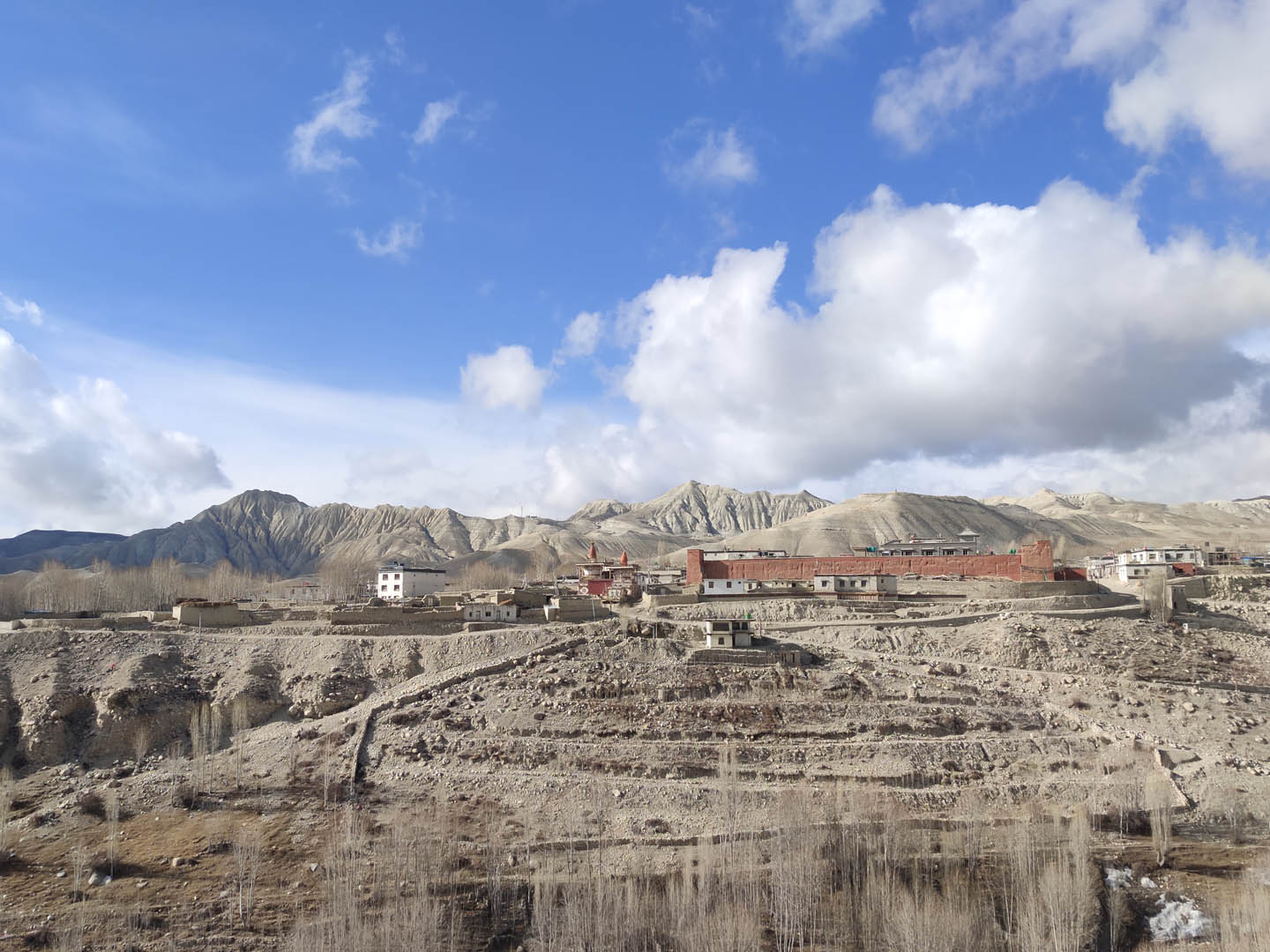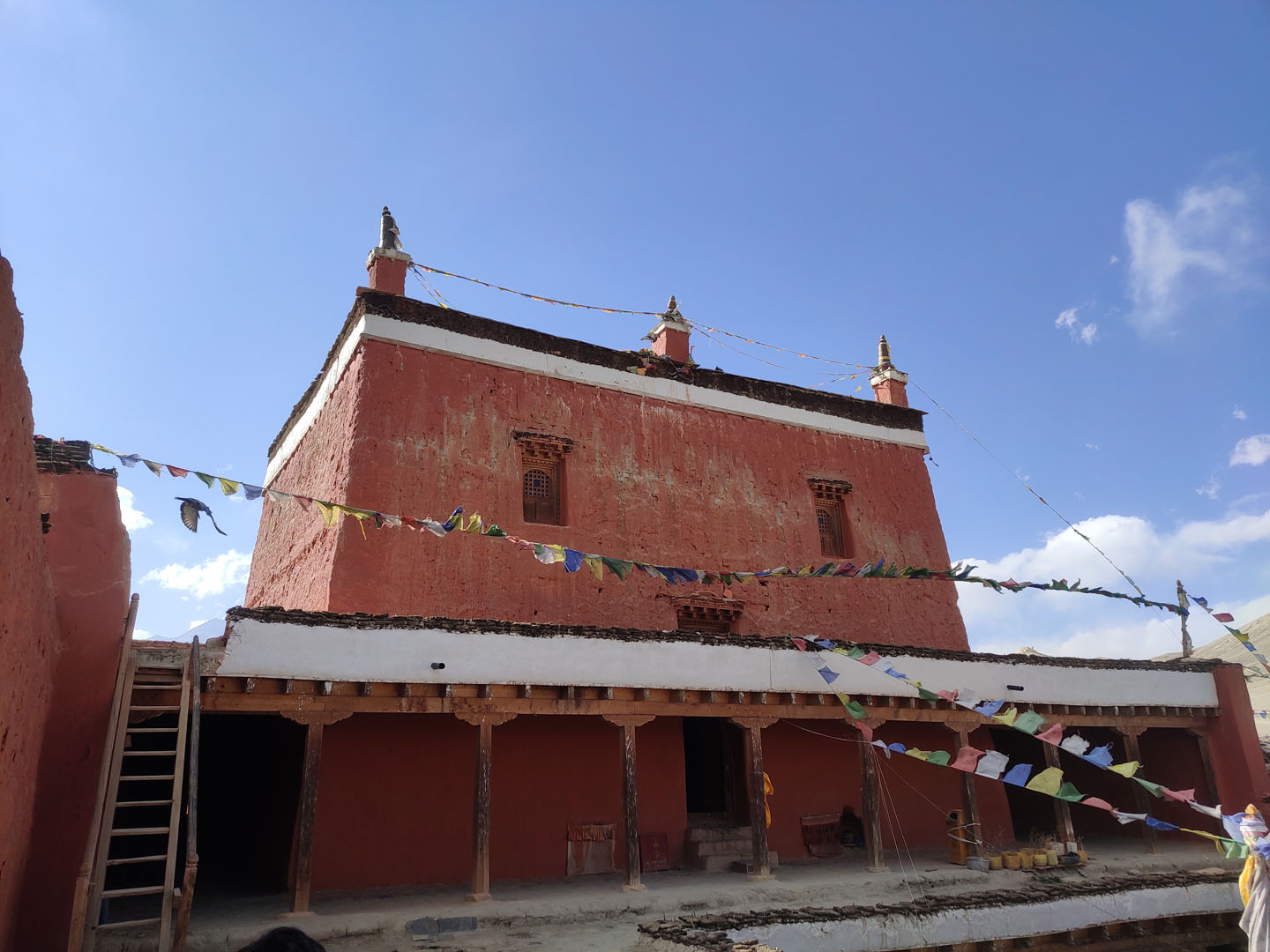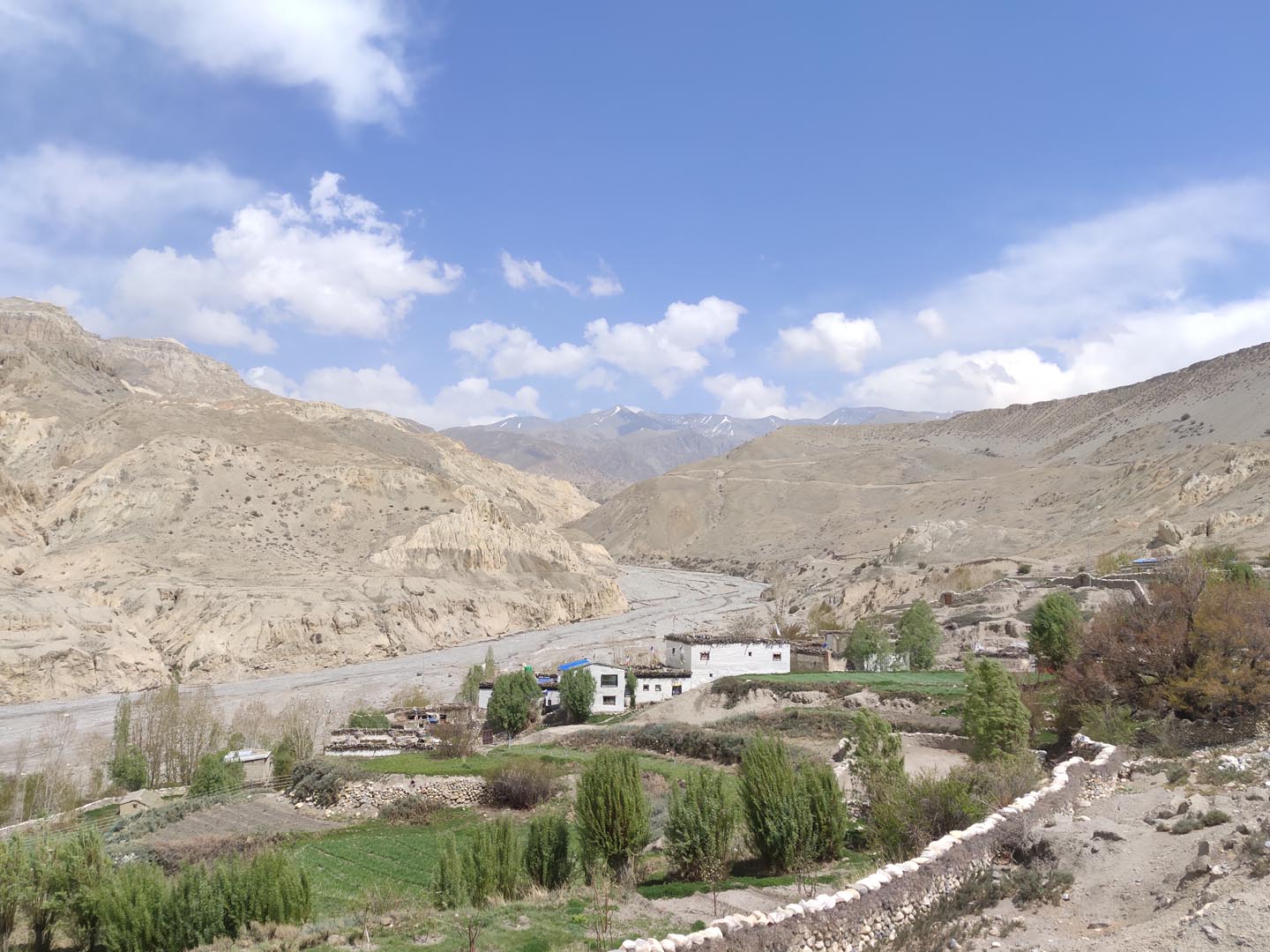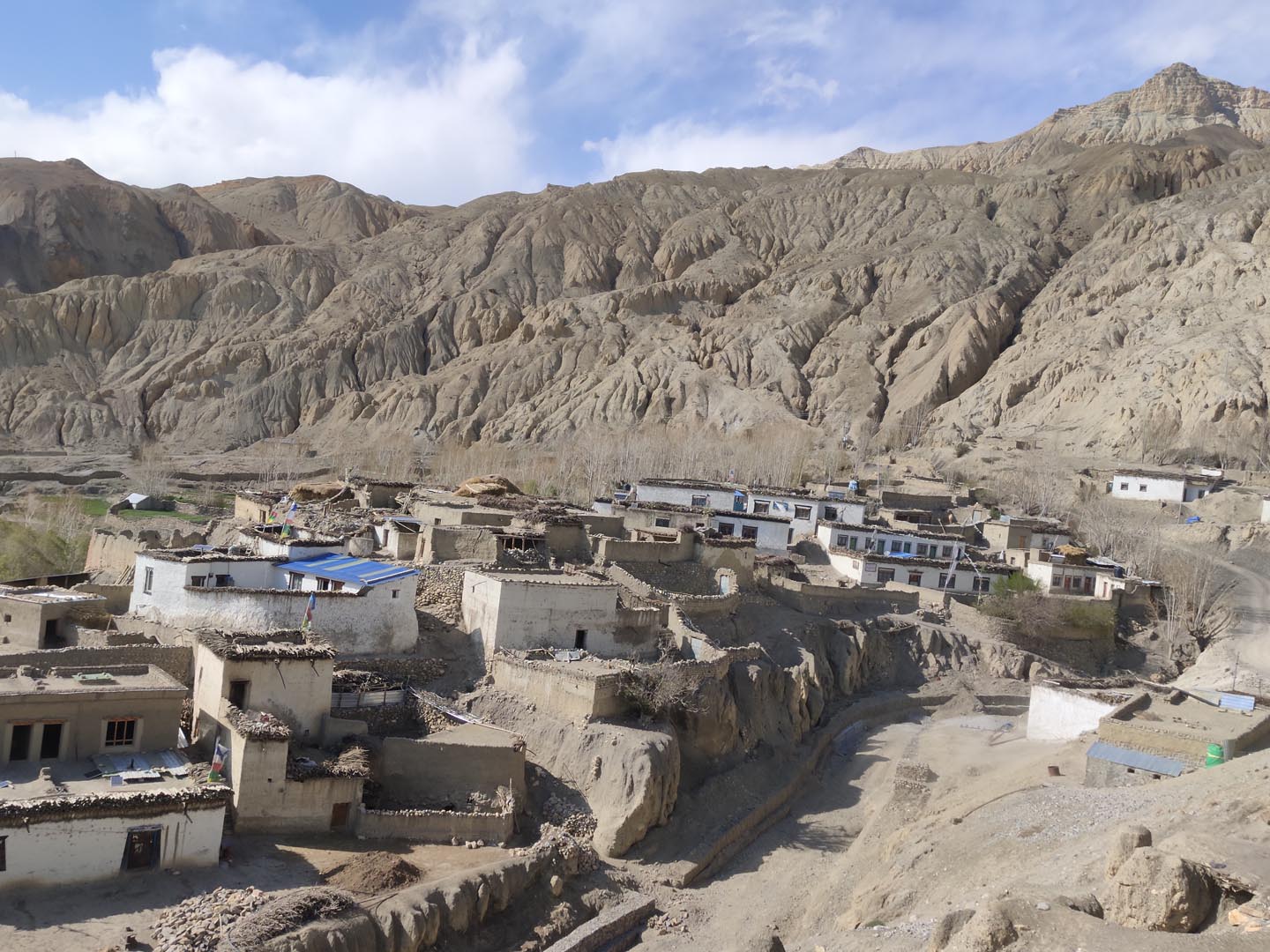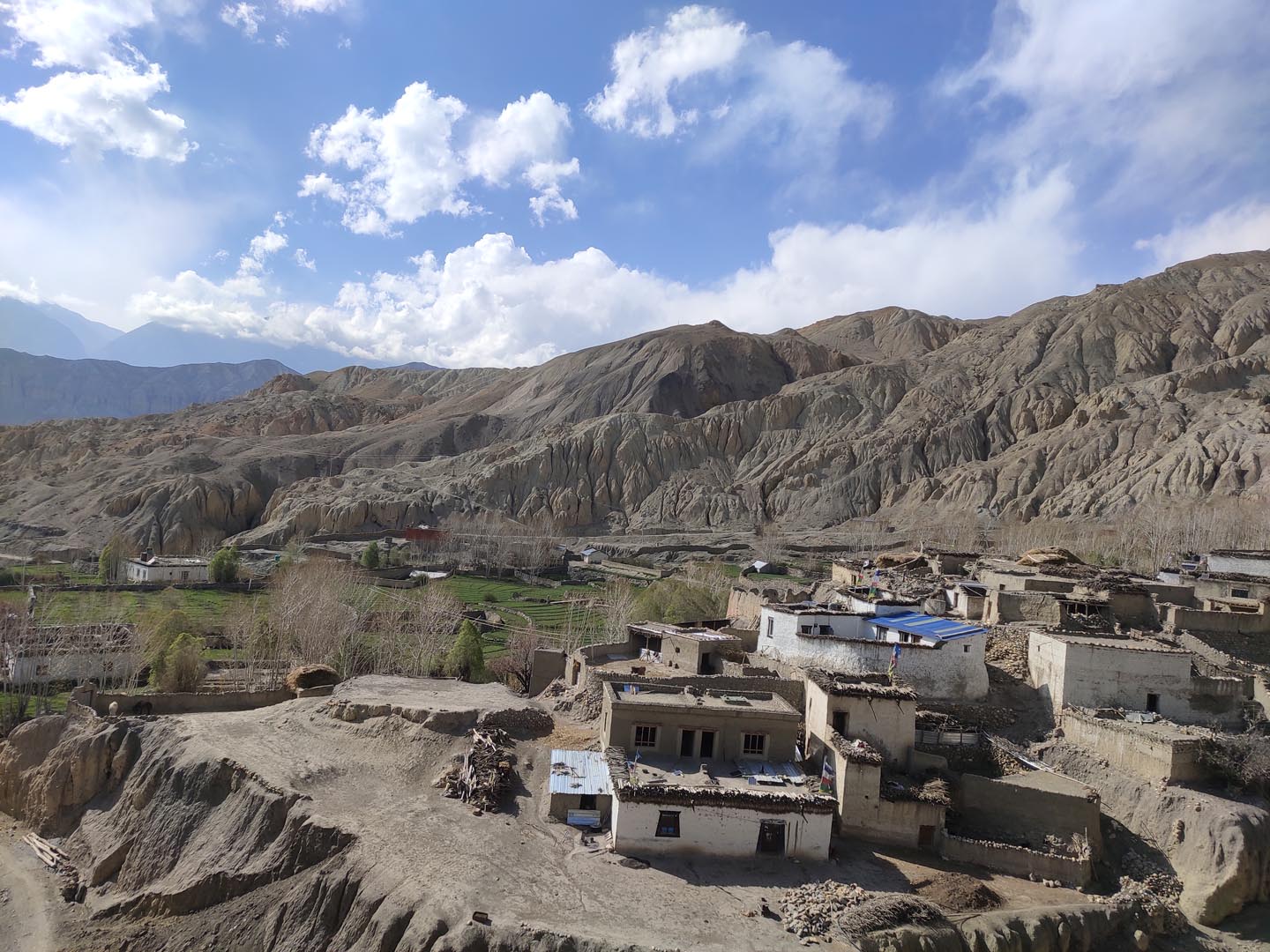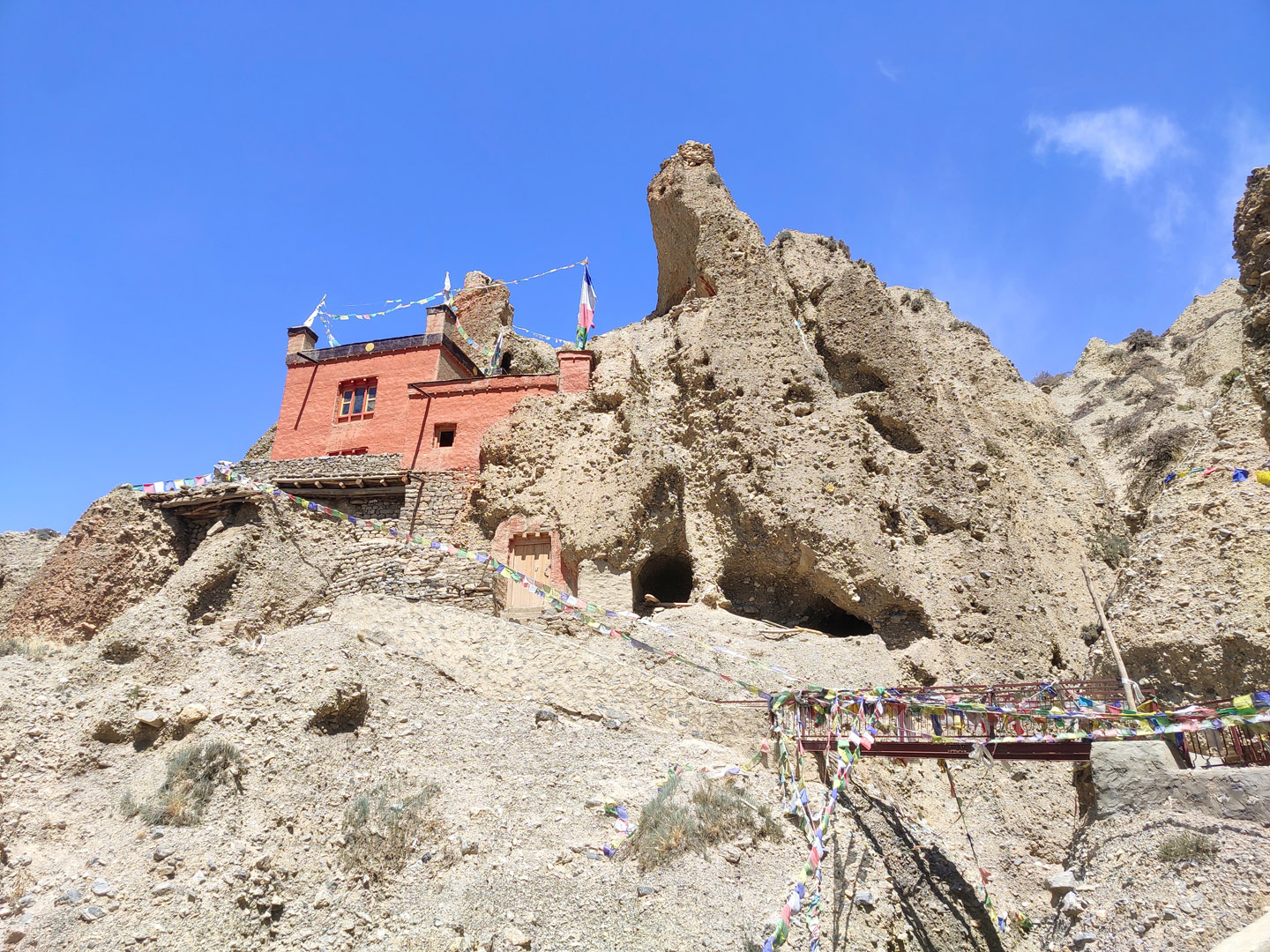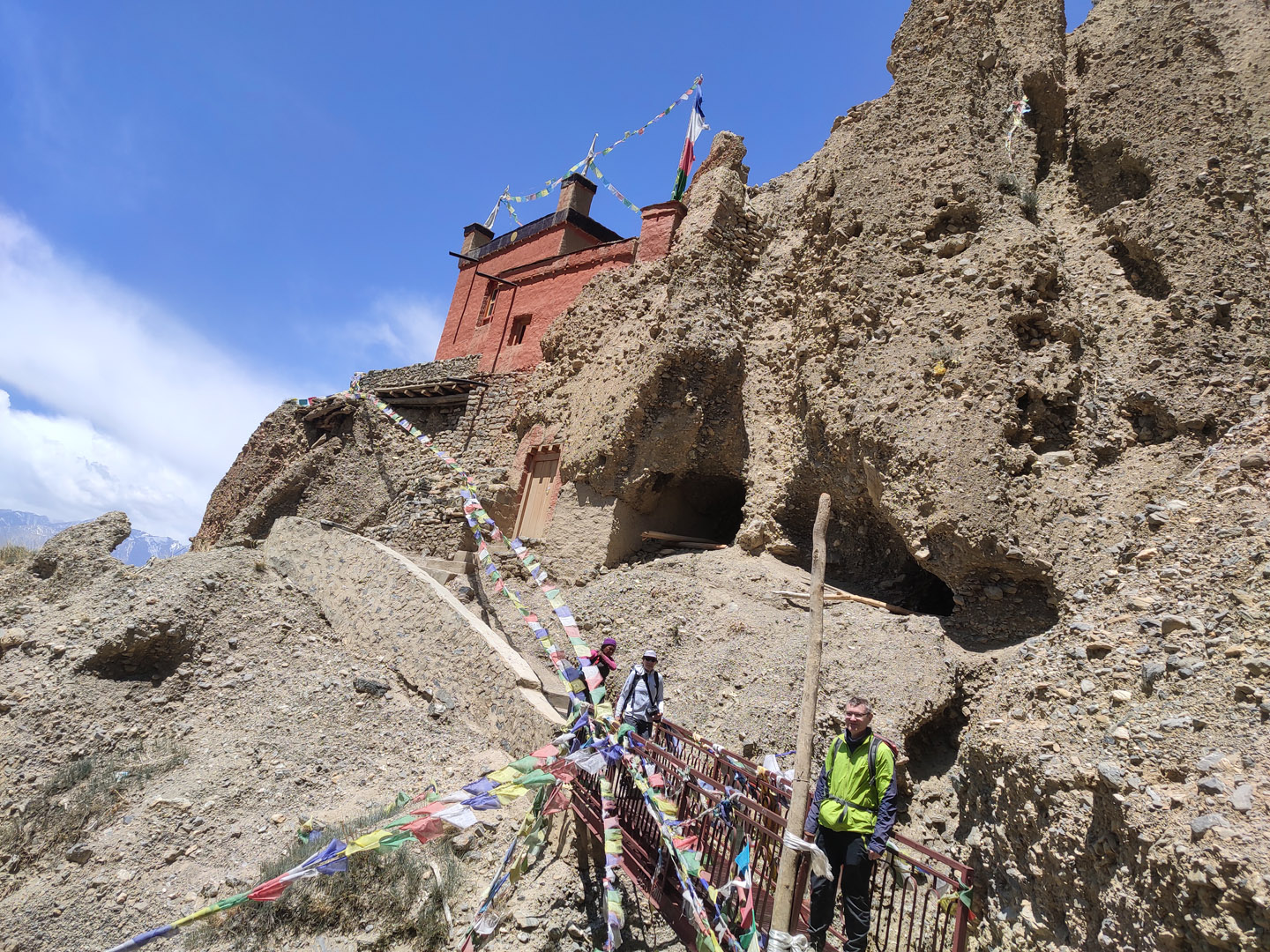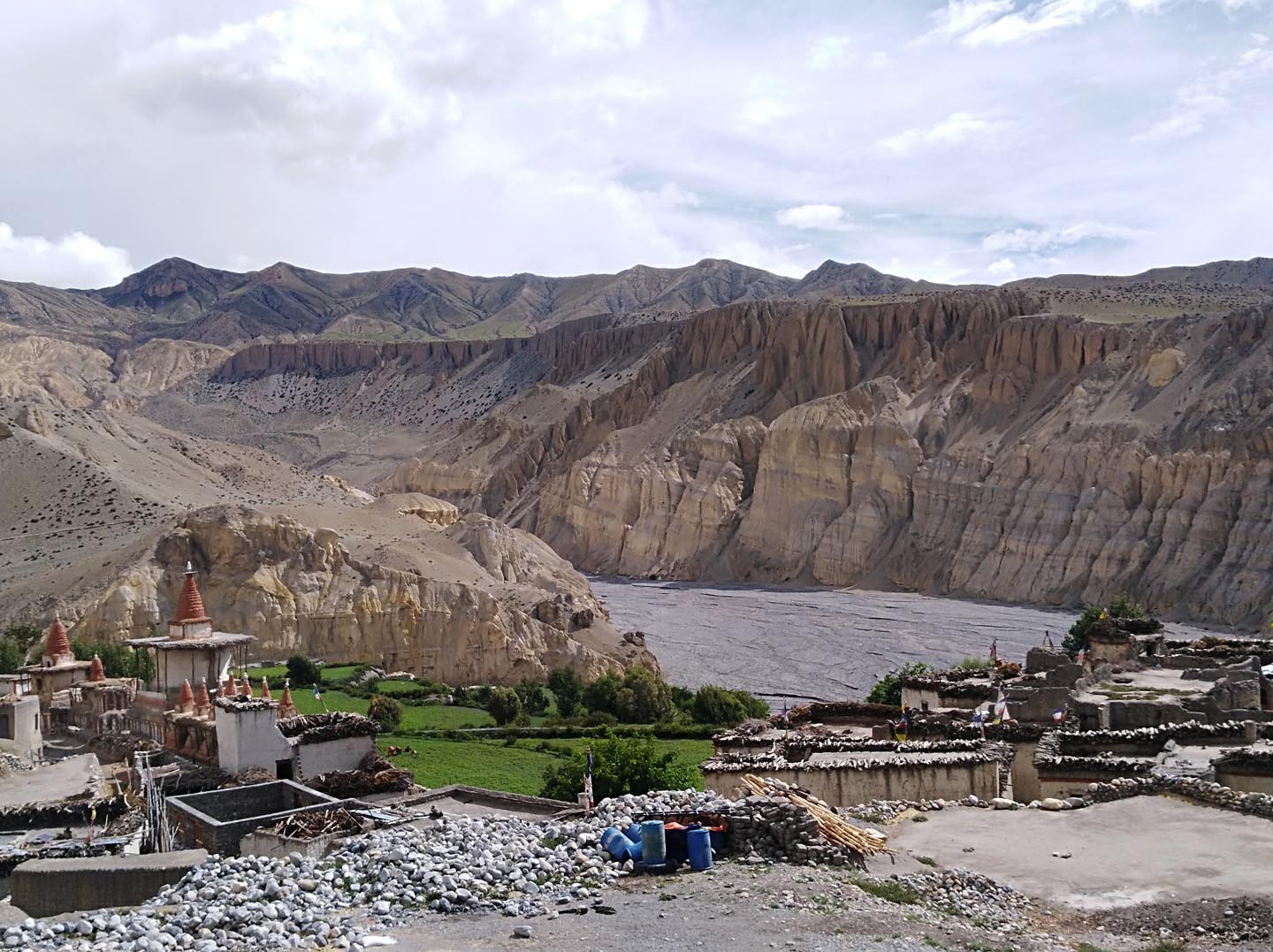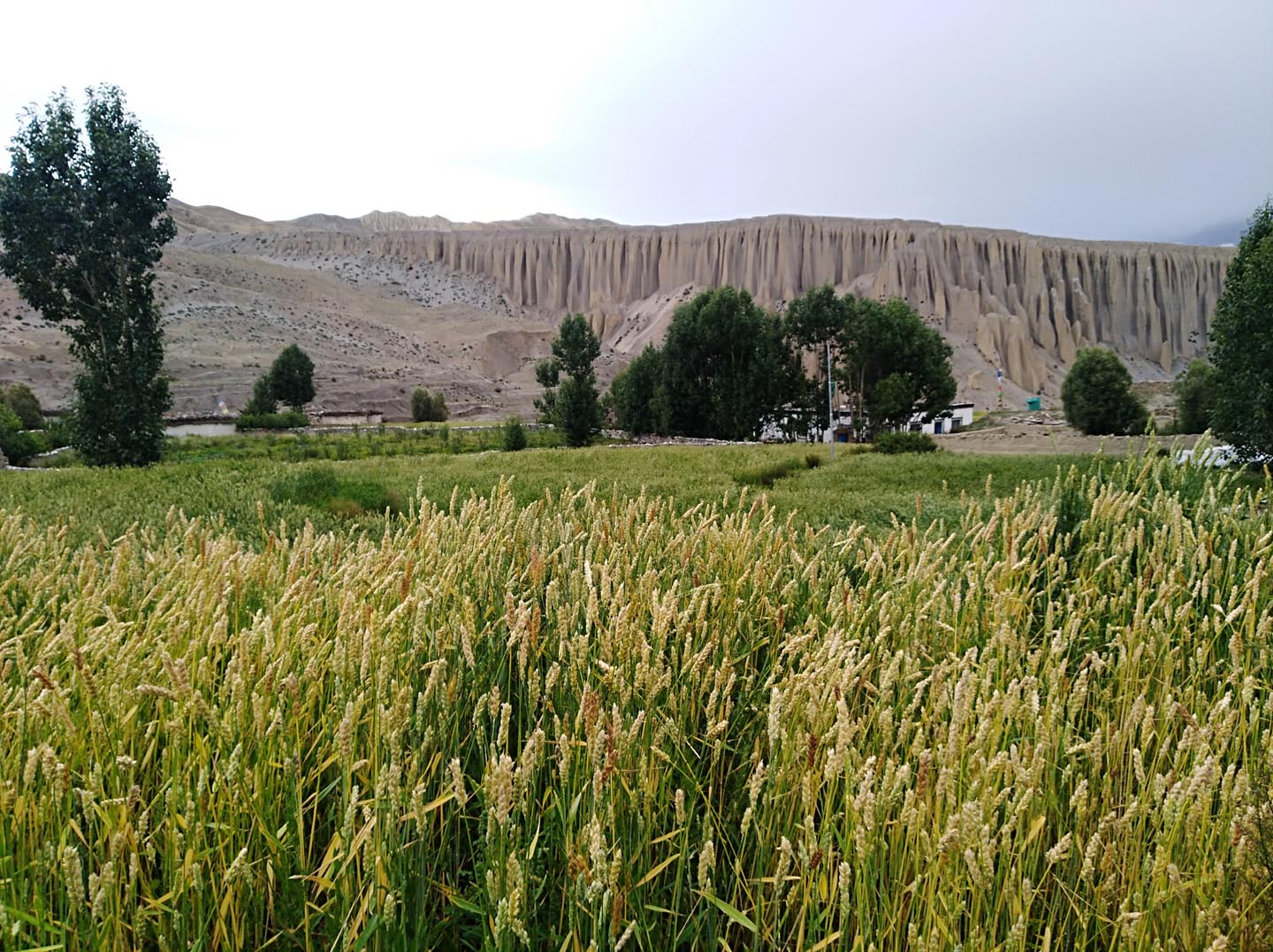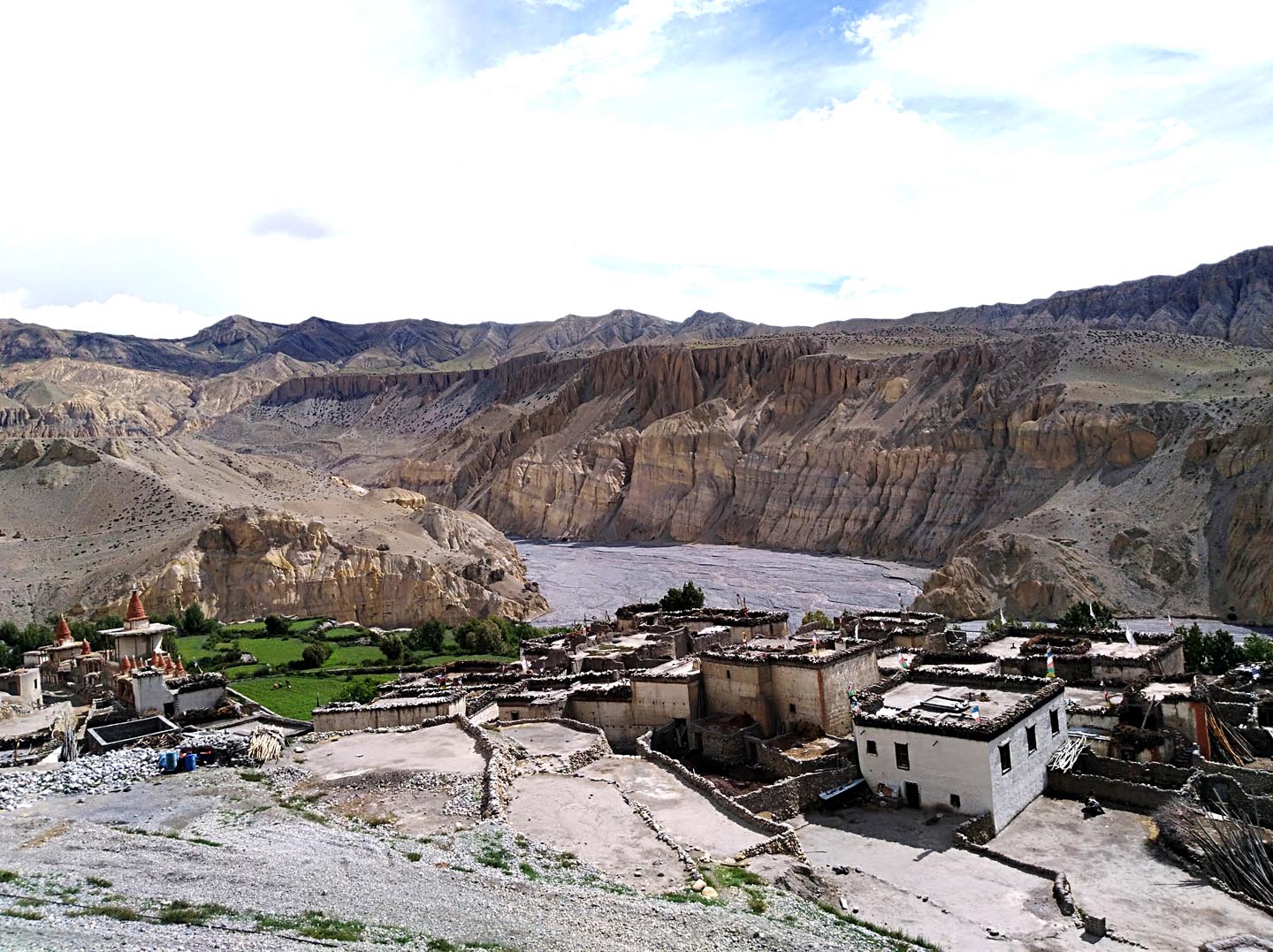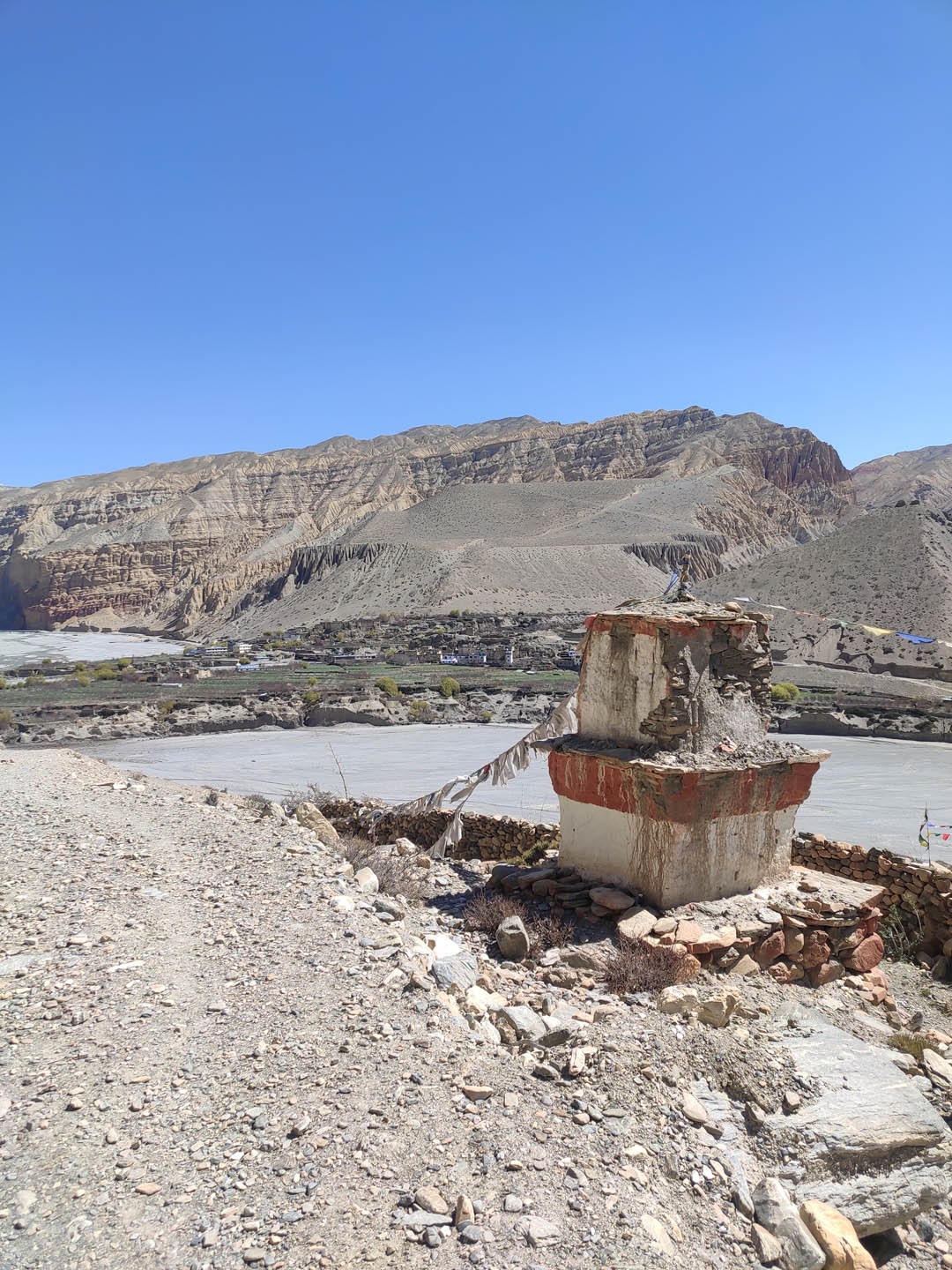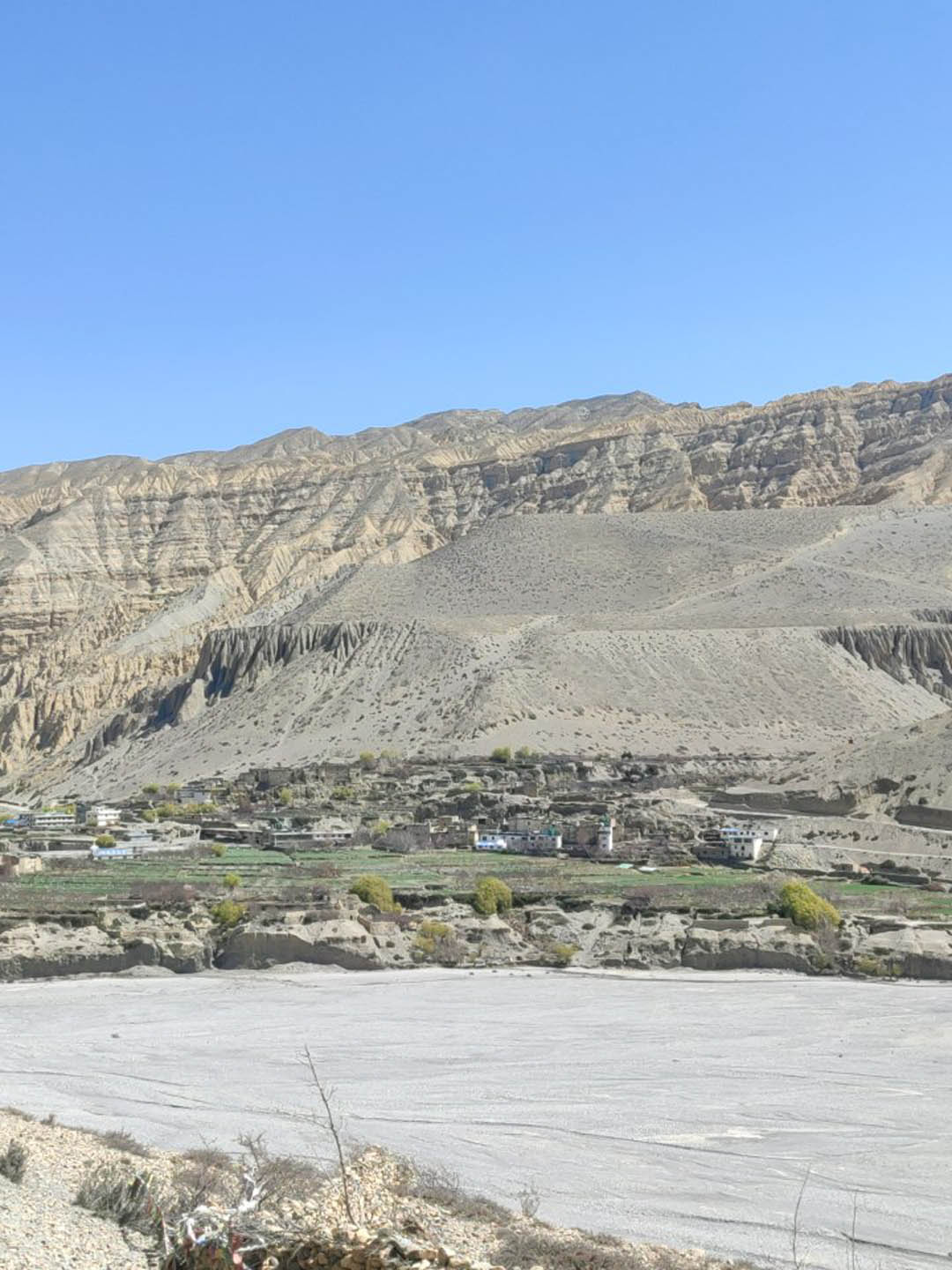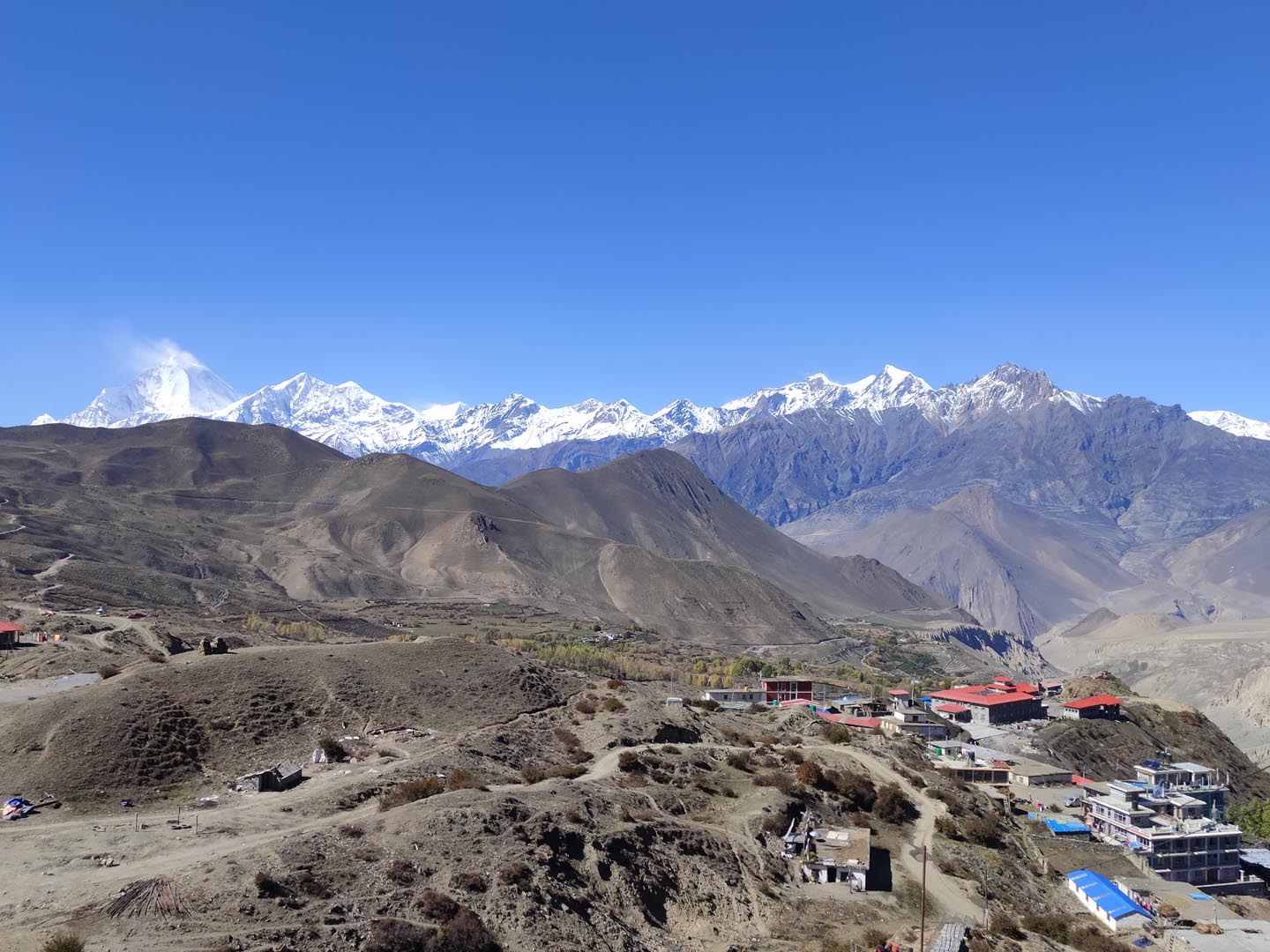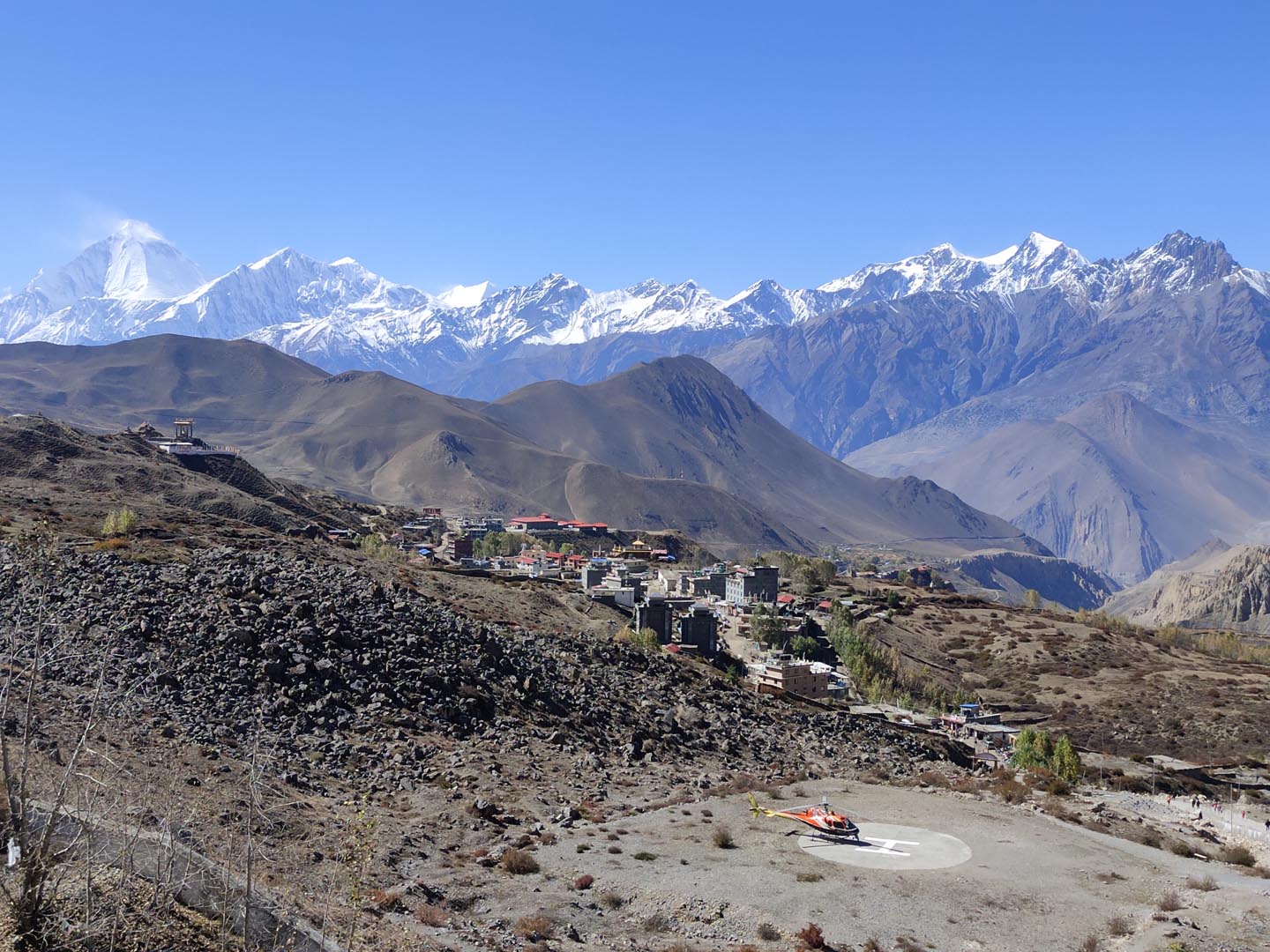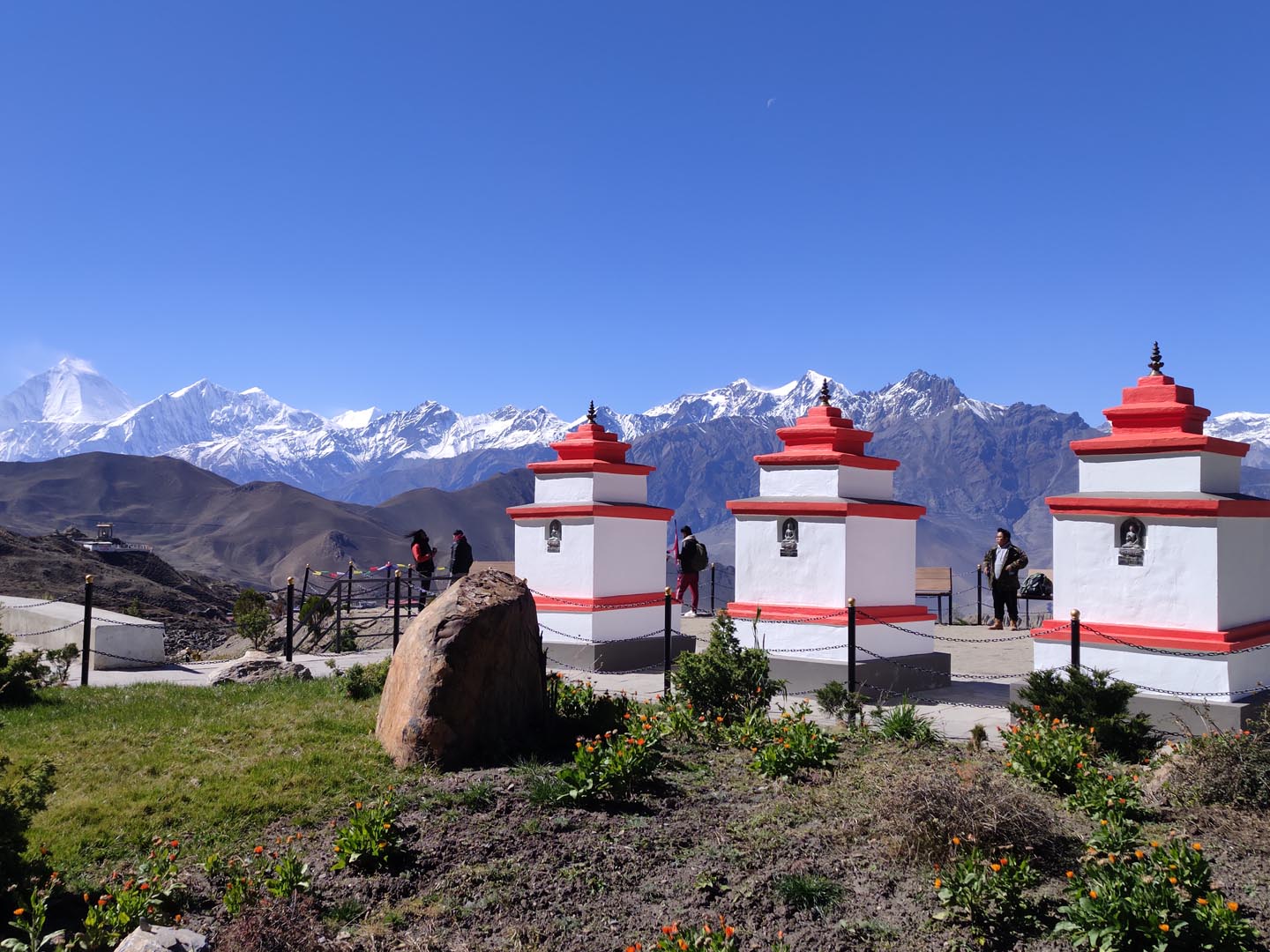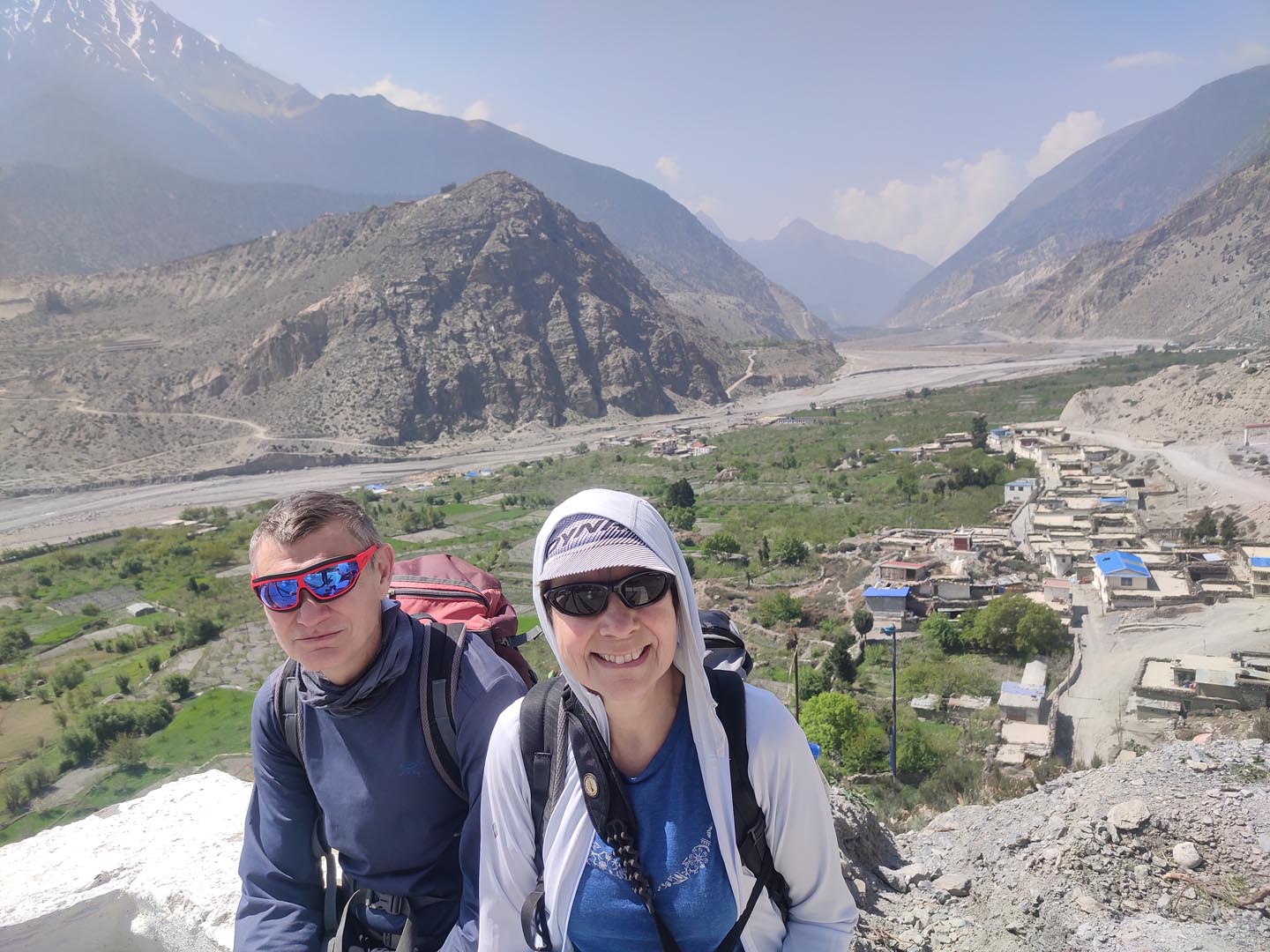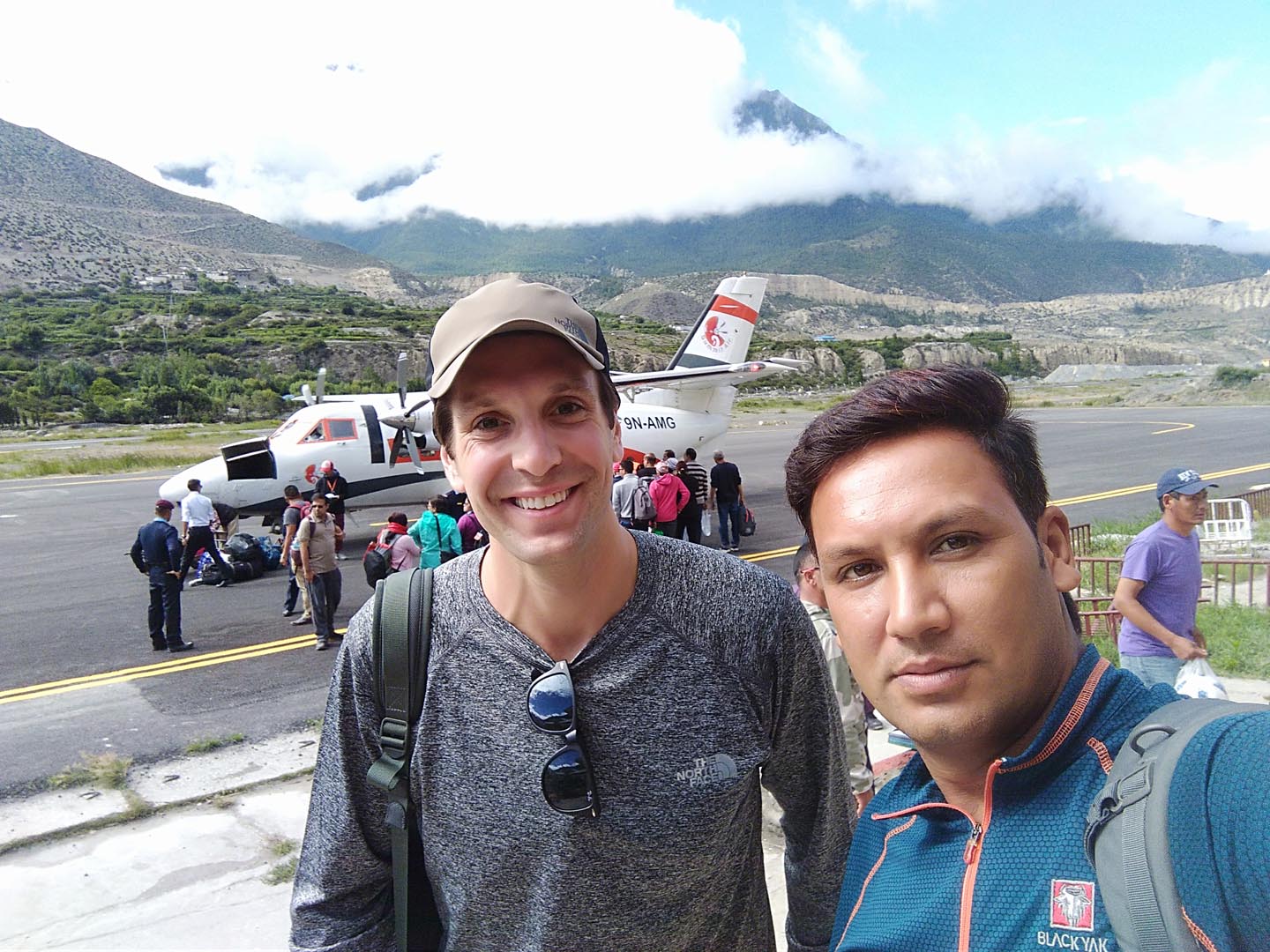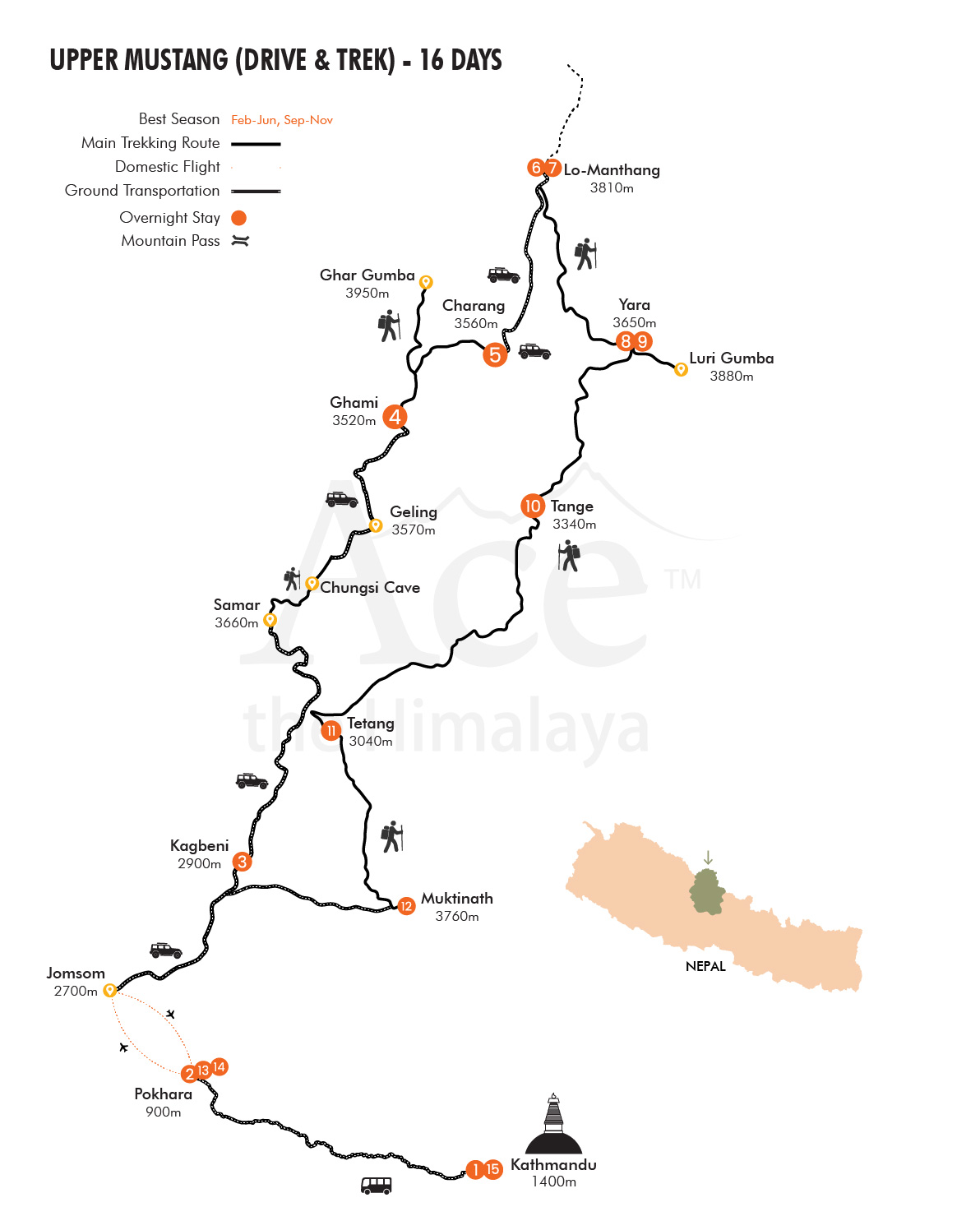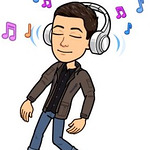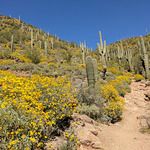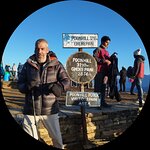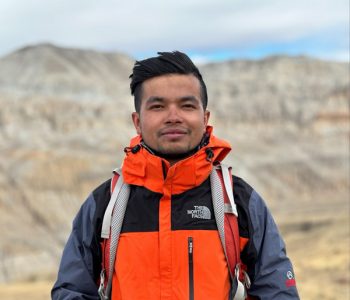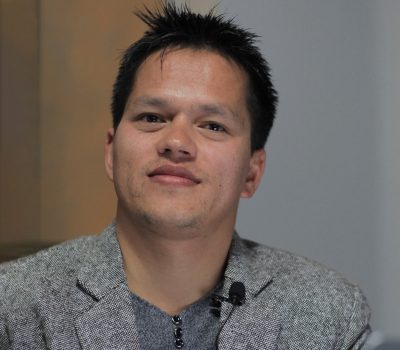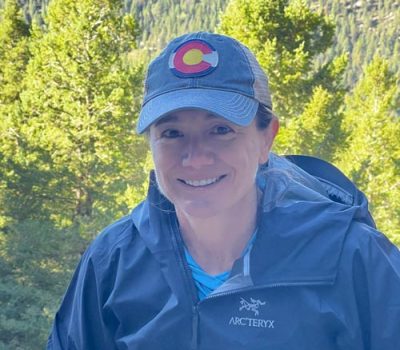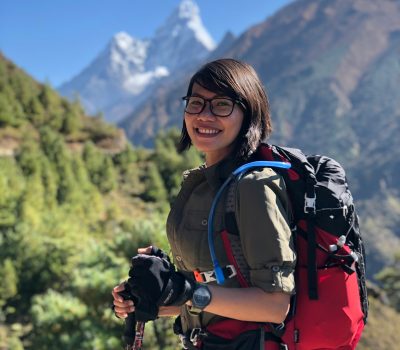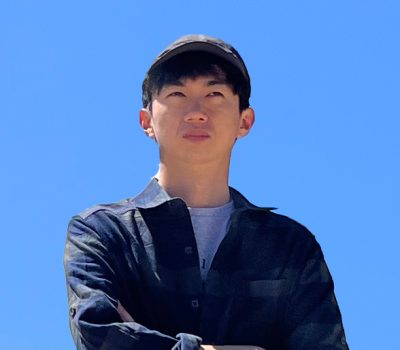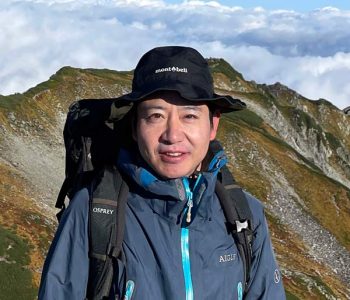Upper Mustang Trek (Drive & Trek) - 16 Days
Grab the opportunity to walk through the barren landscapes of Jomsom and Muktinath, experience the countryside of Nepal and witness the beauty of ancient Tibetan Kingdom.
Upper Mustang Trek Highlights
- Scenic flight round trip over the mountains from Pokhara & Jomsom.
- Stroll across the breathtaking valley of the Kali Gandaki river.
- Explore the hidden kingdom in trans-Himalayan land.
- Tour around manmade sky caves.
- Explore various monasteries in the valley including Ghar gompa, Thokten Gompa, Choten gompa, Luri Gompa, etc.
- A picturesque view of the Himalayas.
- Visit the walled city; Lo Manthang.
- Explore the unique art and architecture of Luri-Gumba perched on a 100 m high cliff of sharp rock.
- Hike across the desolate trails of “Pa-Pass” in Upper Mustang.
- Discover what it’s like to live in the mountains.
- Visit Muktinath, the holiest temple in both Hinduism and Buddhism.
Upper Mustang trek Overview
Upper Mustang trek is a rare and privileged trek in the hidden kingdom of Lo. The fabled medieval wall city of Lo Manthang is the capital of Mustang. In fact, the upper mustang is the kingdom inside the kingdom full of culture and religious heritage in Nepal.
The early history of Lo Manthang is embellished with myth and legend rather than recorded fact. Mustang maintained its status as a separate principality until 1951. The Lo Manthang king is still recognized by that title and holds the honorary rank of Colonel in the Nepalese Army.
Before 1992, the upper Mustang wasn’t open to the outside world. Likewise, it is an undisturbed land with cave dwellings high in the cliffs and stunning architecture. Upper Mustang trek gives you an enhanced experience of the actual life of the real mountain people of Nepal. Similarly, the lifestyle in the Upper Mustang trek is quite similar to Tibet, which is a part of it geographically.
Road accessibility in the Mustang region has affected the trekking route in some places. In light of this, we have also specifically tailored the trip while placing the drive in a moderate location.
Thus, the itinerary combines a drive and a trek, with a focus on a trekking route that avoids the road as much as possible while covering the major attractions of the region, including the King’s Palace, the monasteries, and the enormous caves.
Additionally, all ground transportation in the mountain, as specified in the itinerary, is provided by locally available vehicles, most of which are Indian vehicles such as the Mahendra Scorpio and Bolero.
Short Itinerary
Arrive at Tribhuvan International Airport in Kathmandu (1,400 m) and transfer to the hotel.
Early-morning Drive to Pokhara (900 m) from Kathmandu – 7 to 9 hours. Overnight at the hotel in lakeside.
Early-morning Flight to Jomsom from Pokhara – 30 minutes. Drive to Kagbeni (2,810 m) – 35 to 45 minutes. Overnight at a guesthouse.
Drive to Samar from Kagbeni – 2 to 3 hours. From Samar, you’ll hike up to Chungsi Cave monastery – 2 to 3 hours where you can experience the tranquil Buddhist surrounding; then you’ll hike up to Syangboche – 25 to 30 minutes. Then, a drive to Ghami (3,520 m) – 2 to 3 hours. Overnight at a guesthouse.
Trek to Ghar Gompa (lunch & Gompa exploration) & trek to Ghar Gompa to Charang (3,560 m) – 5 to 6 hours. Overnight at a guesthouse.
Drive to Lo Manthang (3,810 m) from Charang – 2 to 3 hours. Overnight at a Guesthouse.
Explore Lo Manthang; the King Palace, Thupchen Gompa, Chode Gompa “ Dragkar Thegchen ling Gompa”, & Jampa Monastery. Overnight at a guesthouse.
Trek to Yara (3,650 m) from Lo-Manthang – 6 to 7 hours. Overnight at a guesthouse.
Trek to Luri Gumba (3,880 m) & back to Yara – 6 to 7 hours. Overnight at a guesthouse.
Trek to Tangye (3,340 m) from Yara – 6 to 7 hours. Overnight at a guesthouse.
Trek to Tetang (3,040 m) from Tangye – 8 to 9 hours. Overnight at a guesthouse.
Trek to Muktinath (3,760 m) from Tetang – 5 to 6 hours. Overnight at a guesthouse.
Early morning drive to Jomsom for about – 1 to 2 hours & flight back to Pokhara – 30 minutes flights. Overnight at the hotel in lakeside.
Spare day in case of Jomsom to Pokhara flight cancellation due to weather condition. Overnight at a hotel.
Drive back from Pokhara to Kathmandu by tourist bus – 6 to 7 hours. Overnight at a hotel.
Transfer to International Airport in Kathmandu for Your Final Departure.
 Trip Note
Trip Note
Our standard itinerary might slightly differ from the norm because road accessibility in the Mustang region has affected the trekking route in some places. In light of this, we have also specifically tailored the trip while placing the drive in a moderate location. Thus, the itinerary combines a drive and a trek, with a focus on a trekking route that avoids the road as much as possible while covering the major attractions of the region, including the King’s Palace and the monasteries.
In contrast, the unpredictable happenings and events like lack of teahouses in the trails and basic accommodation facilities or any other uncertain calamities are out of our control. Factors such as flight cancellation/delay, unfavorable weather, natural calamities, newly implemented government rules, political affairs, trekkers’ health conditions, etc., are possible. Evaluating the situation’s possible solutions allow the trekking to resume as much as possible based on the best alternatives.
In these times, we look for your cooperation and flexibility.It is advised you arrive one day before the trip start date so you can rest, and it also gives you time to buy clothing, equipment, and gear required for the trek. Also, it is best if you book your flights with spare days in Nepal for this trek in case of any flight delays or cancellations. Moreover, you have options to customize this trip where you can add on a sightseeing tour in Kathmandu, Pokhara, other adventure sports, or day trips around the country before or after the trek.
 JOMSOM Flight Details: All you need to know!
JOMSOM Flight Details: All you need to know!
Twin Otter is the primary mode of transport from the airstrip at Jomsom. This service is pretty dependable. Sometimes, flights may be canceled due to mountain weather conditions or other technical problems. In such a case, Ace the Himalaya will organize the alternative available road transportation to ensure you are on schedule for your international flight. Likewise, for your two-way ground transportation between Pokhara and Jomsom, we use locally available vehicles, which are mostly Indian vehicles like the Mahendra Scorpio and Bolero. The expense of the road transport will be managed from the reimbursement received from the flight ticket after deducting the cancelation charge. So please note that there will be no refund of the flight from Jomsom to Pokhara if the alternative road transportation is consolidated.
Departures & Availability
Our groups are small with minimum two to maximum 14 people. A minimum of two participants are required per departure date as the price is quoted based on minimum 2 customer due to the Upper Mustang restricted area permit. If you are the only person booked for a particular departure, you have the option to either pay a supplement fee of USD 850 to maintain your solo departure.
Looking for personalized experience? We organize privately guided journey which is mainly designed to fit your taste and interest. Please fill out the form below to get started.
Price Includes
- All (international and domestic) airport transfers on a tourist vehicle
Twin-sharing accommodation in a 3-star hotel in Kathmandu for 2-nights and Pokhara for 3-nights including breakfast (Private room accommodation can be organized at an extra cost)
Twin-sharing or domitory guesthouse accommodation during the drive and trek for 10 days in the mountains
- All your standard meals during the trek (Breakfast, Lunch, and Dinner) including seasonal fruits
- Experienced, first-aid trained, government licensed, English-speaking Ace the Himalaya's trekking guide
Permits for Annapurna Conservation Area (ACAP) and Trekkers’ Information Management System (TIMS)
Restricted Area Permit (RAP); US $500 per person
- Porters during the trek for carrying luggage (1 porter for every 2 clients)
- Wages, accommodation, meals, gear, insurance, and medications for all staff
- Filtered water in the trails using Water Filter or using water purification tablets
Round-trip airfare between Pokhara and Jomsom including airport departure taxes in Jomsom airport
Round trip tourist vehicle fare between Kathmandu and Pokhara
- 1 Ace the Himalaya’s duffel/kit bag, trekking map, sun hat, Buff (Neck Gaiter) and trip completion certificate
A farewell dinner on the last night in Pokhara
All ground transportation in the mountain, as specified in the itinerary, is provided by locally available vehicles, the majority of which are Indian vehicles such as the Mahendra Scorpio and Bolero
- All administrative expenses and government taxes
Price Excludes
- Meals (lunch and dinner) in Kathmandu and Pokhara
- International flight fare and airport departure tax
- Any beverages including bottled and boiled water
- Travel insurance along with high-altitude emergency evacuation coverage
- Tips to trekking staff and driver
- Nepal Entry Visa (Visa can be acquired easily after your arrival at Tribhuvan International Airport in Kathmandu with a fee of USD 50 for 30 days visa and USD 125 for 90 days visa)
- Personal Trekking gear and equipment
- Any expenses other than the Price Include section
Upper Mustang tTek Itinerary
Expand AllDay 01: Arrive at International Airport in Kathmandu and transfer to the hotel
Our airport representative will be receiving you at Tribhuvan International Airport, Kathmandu and s/he will be displaying an Ace the Himalaya signboard outside the airport terminal. You will be then transferred to your respective hotel in our private tourist vehicle.
Note: If you arrive after 4 pm, there will be a briefing about the trip with our guide. It will be a short pre-trip meeting. Make sure to confirm your queries about trekking in the mountains. If you arrive before 4 pm, a pre-trip meeting will be organized at our office on the same day. Meet and greet with our trip guide.
Be sure to bring the following documents to the meeting; two copies of passport-sized photos and a readable copy of your travel insurance policy. These documents help to acquire trekking permits and related documentation during the trek. Pay the remaining balance of your invoice and sign in the legally binding trip form and non-liability disclaimer.
Day 02: Early morning drive to Pokhara from Kathmandu by Tourist Bus
Our trekking staff will pick you up from the hotel at 6:30 am and escort you to the tourist bus station. The bus to Pokhara leaves at around 7:30 am. Pokhara is a beautiful valley set on the banks of Phewa Lake.
 Pokhara Road Update
Pokhara Road Update
Please be advised that extensive road construction between Kathmandu and Pokhara has resulted in increased traffic congestion and air pollution. As a result, the journey, typically taking around 6-7 hours, may now require approximately 8-9 hours. We appreciate your patience and understanding during this time. Alternatively, there is the option to take a 30 min flight from Kathmandu to Pokhara and vice versa. The cost for a one-way flight is USD 130 per person.
The city is also known for its panoramic views of Annapurna and Machapuchare (the shape of a fish tail) in the north, Dhaulagiri in the west, and Lamjung Himal and Manaslu in the east. It is smaller and much less hectic than Kathmandu, hence providing the perfect starting point for our Upper Mustang Trek.
Day 03: Early-morning Flight to Jomsom from Pokhara. Drive to Kagbeni
Early morning you will be flying northwest from Pokhara towards the great portal between the snow-capped peaks of Annapurna and Dhaulagiri. You will enjoy the well-raised massifs of more than 8,000 m and the deepest gorge on this planet.
On arrival at Jomsom, you will meet the rest of the trekking staff. From Kathmandu, you will have a guide with you. You start to trek towards Kagbeni, the main gate to Upper Mustang and the trek will take you around 4 and half hours to reach Kagbeni.
Day 04: Drive to Samar from Kagbeni. From Samar, you'll hike up to Chungsi cave monastery, where you can experience the tranquil Buddhist surrounding; then you'll hike up to Syangboche. After Syangboche we'll drive towards Ghami
Today we might have a long day as the itinerary includes a drive and a trek. First, we’ll take a beautiful drive from Kagbeni to Samar, which is at 3,600 m. It will take us there in approximately 2 to 3 hours.
After reaching Samar, we’ll have our lunch there. After having our lunch, we will begin our about 2 to 3 hour hike from Samar to Chungsi Cave Monastery. The Chungsi Cave Monastery is a monastery inside the cave. Similar to this, we will climb for around 30 minutes to reach Syangboche Monastery at 3,850 m after touring Chungsi Cave Monastery. In Syangboche, we’ll explore the monastery and again have our drive towards Ghami.
After having a day full of driving and a trek, we’ll stay for a night in Ghami. Along the trail, we’ll be walking and exploring the dry and desertic landscape of Mustang.
Day 05: Trek to Ghar Gompa, also known as “ Lo Gekar Monastary” & trek to Ghar Gompa to Charang
While on your trek, you have the chance to stop by two additional settlements. The climb to Lo-Gekar continues. One of the oldest gompas in Nepal is Lo-Gekar Gompa, which is older than Samye Gompa in Tibet. Inside the gompa, it is thought that “Padmasambhava” meditated.
The Ghar Gompa, which dates back to the year 1200, is a short distance away from there where they worship Guru Rinpoche as their main figure. The Gompa is renowned for its rock carvings as well.
It takes roughly three and a half to four hours to get here from Ghami. The Ghar Gompa is said to grant the wishes of everyone who makes a wish there. After an hour of Ghar Gompa exploration, the journey continues in the direction of Charang, where we will spend the night. Charang can be reached from Ghar Gompa in 2 to 3 hours.
Please be informed that from Ghar Gompa to Charang, we will be walking on a road used for both vehicle transportation and hiking.
Day 06: Drive to Lo Manthang by local Private tourist vehicle, from Charang
We arrive at Lo-Manthang, our final stop, on day 6. It will take us another 2 to 3 hours to drive from Charang to Lo-Mangthang on our trip.
Every hike or journey to the Upper Mustang ends in Lo-Manthang. It is the capital of the ancient city of Upper Mustang and is located at a height of 3,810 meters above sea level. In addition, the settlement is completely surrounded by walls, earning it the name “walled city.”
Please be aware that you will have the option to avoid the drive from Charang to Lo Manthang in favor of a trek. The trek takes between 5 and 6 hours and the drive takes about 2 to 3 hours.
Day 07: Explore Lo Manthang
We have an additional day in Lo-Manthang today, so we’ll explore the city a little bit more, taking in the King’s palace and other surrounding tourist attractions. The Lhobas people’s Tibetan culture is one of the main draws in Lo Manthang.
Additionally, the settlement is thought to include 12 caves with old Buddhist paintings that are located at the edge of a 14,000-foot steep cliff. While exploring around the city on this day, we’ll be walking for 3 to 4 hours.
Day 08: Trek to Yara from Lo-Manthang
From Lo-Manthang, the trail walks straight to Dhi Pass (4,100 m) and descends to Dhi village within 5 to 6 hours of the trek. The trek from Lo Manthang to Muktinath is harder but more rewarding and interesting than the west side of the valley.
Dhi village is one of the best villages in all of Lo-Manthang, and it seems more prosperous and settled in a very suitable place. We then cross a river and follow a path along the left bank of the river to Yara village at 3,650 m.
Day 09: Trek to Luri Gumba & trek back to Yara.
From Yara, the trek to Luri Gumba will take roughly three hours. The Nyingma Kargyupa Sect of Tibetan Buddhism is linked to Luri Gumba. One of the most well-known gompas in the area, it is perched on a 100-meter-high cliff of sharp rock.
The monastery has a distinctive building inside the cave with two chambers and natural pillars made of sandstone. We’ll hike back to Yara for the night after exploring Luri Gomba.
Day 10: Trek to Tangye from Yara
The trek departs from Yara and traverses a river from Damodar Kunda, one of the holy lakes, for around two hours. You must cross this river with bare feet because there is no bridge across it. Following the river crossing, the trail ascends steeply to a 3,850 m pass.
The trail winds through a hill that has no trees or grass. Following the pass, the trail descends once more swiftly to Tangye hamlet, which is located at a height of 3,340 m.
Tangye is a small village with about 30 homes, although the majority of them are connected to one another. The prosperity of their civilization is also reflected in the piles of dry wood that can be seen on the rooftops. On this day, we’ll examine the Tibetan way of life and the massive little stupas.
Day 11: Trek to Tetang from Tangye
We will trek across the dry, desolate land of this trip as we make our way toward Tetang. We have attempted to avoid the transportation route as much as possible on this trail. Until we reach the “pa- pass,” we will be trekking along this trail without any teahouses.
Yes, by barren land, we mean that there aren’t any places to refill your water, therefore on this day, we’ll be carrying our packed lunch. We’ll arrive at the “pa-pass,” where you can finally find water to refuel, in approximately 3 to 4 hours. Finally, after crossing the Pa Pass, we will arrive at “tetang,” which is our final stop for the day.
Since there are no tea houses along our route, please be aware that we will be carrying our packed lunches with us. In order to stay hydrated in between the trails, don’t forget to pack a water bottle with 4 to 5 liters of water.
Day 12: Trek to Muktinath from Tetang
This is the last day of the trek. After crossing the picturesque Mani walls, we continue on our path through the hamlet. Following the plateau, we continue to climb till we get to a little pass, from where we can see the majestic Muktinath temple and high mountains in the distance. We proceed past the kani (gate) on the path that would take us to the Muktinath temple. We walk around the temple and take a short break.
Muktinath is a sacred Hindu and Buddhist temple located at an elevation of 3,760 m above sea level. Additionally, it is one of the highest-altitude temples in the world. Muktinath means “Liberation Arene.” It is believed by the devotees that washing yourself in the 108 watercourses of Muktinath will give you liberation.
Day 13: Early morning drive to Jomsom for about & flight back to Pokhara
After staying the night in Muktinath and seeing the surrounding area, we’ll board a local Jeep and head back to Jomsom. The trip there will take about an hour.
As a result, once we get to Jomsom, if the weather cooperates and we get lucky, we’ll take a flight to Pokhara; otherwise, we’ve built in an extra day to our schedule in case something goes wrong or there is a flight delay.
Therefore, we will either wait for better weather or swap to a locally accessible vehicle, such as a Mahendra Scorpio or a Bolero and drive toward Pokhara. Please be aware that your airfare cost will be repaid in this situation when the vehicle price has been appropriately adjusted.
Day 14: Spare day in case of Jomsom to Pokhara flight cancellation due to weather condition
We have reserved an extra day in Jomsom in case of flight delay or cancellation due to inclement weather, taking into account the traveler’s anticipated departure date from Nepal. In such circumstances, as we have already stated, we will drive back to Pokhara and arrive in Kathmandu in accordance with our itinerary.
Besides, if we arrive in Pokhara without any unfortunate circumstances, we’ll use this spare day as an exploration day in Pokhara. Additionally, we’ll also have our farewell dinner today at the end of the day.
Day 15: Drive back from Pokhara to Kathmandu by tourist bus
We will be driving back to Kathmandu in the morning on the Tourist bus.
 Pokhara Road Update
Pokhara Road Update
Please be advised that extensive road construction between Kathmandu and Pokhara has resulted in increased traffic congestion and air pollution. As a result, the journey, typically taking around 6-7 hours, may now require approximately 8-9 hours. We appreciate your patience and understanding during this time. Alternatively, there is the option to take a 30 min flight from Kathmandu to Pokhara and vice versa. The cost for a one-way flight is USD 130 per person.
If you are interested in continuing onto Chitwan Jungle Safari, River Rafting Adventure, Kathmandu Shopping Tour, or Scenic Everest Flight, you may opt for them.
Day 16: Transfer to International Airport in Kathmandu for your Final Departure
It’s the end of our exciting journey in the Mustang Region! Today we conclude our Upper Mustang Trek. One of our airport representatives will accompany you to the International Airport for your flight back home. We bid you farewell and hope you’ll travel to Nepal again.
Gears and Equipment
Here is a list of what you might want to pack for the hike. Please take this as a starting point. You’ll need layers of warmer clothing during the winter. We provide a 75 liter duffel bag for you to use for the trek. It will be given to you during your pre-trip meeting in Kathmandu. The duffle bag is yours to keep. Also, you can rent sleeping bag and down jacket with us at the additional fee of USD 35 for each once you are in Kathmandu.
General
- Four-season (zero degree) sleeping bag (We have rental sleeping bags available for an additional USD 35)
- Puffy down jacket (We have rental jackets available for an additional USD 35)
- Daypack (35-45 liters recommended) with rain cover
- Sleeping bag liner
Upper Body
- Sun hat or cap (We'll provide you with a free Ace the Himalaya baseball cap.)
- Knitted hat/Beanie
- Headlamp
- Sunglasses
Torso
- Technical fabric base layer (light for warmer months, heavy for colder months)
- Technical fabric short (2) and long sleeve (2) shirts
- Waterproof, windproof shell
- Fleece jacket or pullover
Lower Body
- Technical fabric base layer (light for warmer months, heavy for colder months)
- Hiking pants (2)
- Comfortable pants for inside the teahouses
- Waterproof, windproof shell
- Hiking shorts
Hands
- Wool or technical fabric liner gloves
- Hard-shell outer gloves (insulated for colder months)
Feet
- Wool or technical fabric warm socks
- Hiking socks
- Liner socks (optional such as silk)
- Trekking/hiking boots (waterproof recommended)
- Ice Cleats /Micro Spikes (For trekking from November to March, it's recommended to include Ice Cleats/ Micro Spikes to prevent slipping on icy or wet surfaces.)
- Casual shoes
- Gaiters (lightweight for dust or heavy for snow in colder months)
Undergarments
Note: The quantity of each article of clothing can be adjusted to suit the preferences of each participant.
- Technical fabric/quick drying is best for underwear (opportunities to launder during the trip)
- Sports bras (women)
- Pajamas or sleeping clothes
First Aid Kits and Medications
- (Note: Guides carry medications and first aid kits during the trip. However, personal kits and medications are highly recommended.)
- Sunscreen
- Lip balm
- ointment
Other Essentials
- Passport
- Extra copies of passport-sized photos
- Reusable water bottle
- Toiletry kits
- Water purification tablets or UV water purifier (if you plan to treat water)
- Hydration bladder
- Towel
- Pillowcase
- Toilet paper (2 rolls)
- High protein snacks (such as protein bars or nuts)
- Waterproof/dry bags for carrying important documents and money
- Airline tickets (Please leave a copy at our office in Kathmandu. This can be useful if there is a change in the date of the flight.)
Optional
Once in Nepal, if you have the time, you can purchase supplies and gear for hiking. Thamel, Kathmandu’s tourist hub, is home to many shops where you can get a variety of reasonably priced trekking equipment.
- Power bank or extra batteries
- Cameras and mobile phone
- Cards/book
- Binoculars
- Trekking poles
- Whistle
- Thermos for hot water
Important Information
- We give you a free duffel bag and baseball cap during your pre-trip meeting in Kathmandu. The duffel bag will be used to pack your trekking supplies.
- For every two participants, we assign one porter. The duffel bag, which should weigh around 10 kg/22 lbs, will be carried by the porter throughout the walk.
- To carry your daily necessities like cash, crucial papers, a water bottle or bladder, a camera, toiletries, sunscreen, a notebook, clothing, etc., you must have your own daypack (with a waterproof cover).
- You can store your luggage (non- trekking items) at the hotel in Kathmandu.
- Down jacket with a hood is a must for altitudes above 4,000 m to keep warm. You can rent a down jacket for USD 35. Please note that in case of loss or damage, you need to reimburse the cost of USD 100 per item.
- You can rent a 4-season sleeping bag for USD 35. Please note that in case of loss or damage, you need to reimburse the cost of USD 100 per item.
Note: Some clothing, especially form-fitting, figure-hugging items made of elastic material (like yoga pants), may offend locals. Therefore, if you choose to wear these clothes for comfort, please make sure to wear something over them.
Trip Video
FAQs for Upper Mustang Trek (Drive & Trek)
General
Is this departure guarantee to run?
A minimum of two participants are required per departure date as the price is quoted based on a minimum of 2 customers due to the Upper Mustang restricted area permit. If you are the only person booked for a particular departure, you have the option to either pay a supplement fee of USD 850 to maintain your solo departure. A minimum of two participants are required per departure date as the price is quoted based on a minimum of 2 customers due to the Upper Mustang restricted area permit. If you are the only person booked for a particular departure, you have the option to either pay a supplement fee of USD 850 to maintain your solo departure.
Why trek with Ace the Himalaya?
Ace has a reputation for successfully leading treks with knowledgeable leaders and staff taking care of all your travel needs. We are a certified sustainable travel company that also endorses the idea of giving back to the community by participating in various philanthropic activities. Here are 17 reasons why you should choose Ace the Himalaya for your next adventure!
Do we avoid the road while trekking to Upper Mustang?
Yes, we have specifically tailored the trip while placing the drive in a moderate location. Thus, the itinerary combines a drive and a trek, with a focus on a trekking route that avoids the road as much as possible while covering the major attractions of the region, including the King’s Palace and the monasteries.
Additionally, all ground transportation in the mountain, as specified in the itinerary, is provided by locally available vehicles, most of which are Indian vehicles such as the Mahendra Scorpio and Bolero.
Is Nepal open to travelers following the Covid-19 pandemic?
Indeed, Nepal is entirely open. Travelers are welcome in Nepal without any restrictions. Arriving travelers can obtain a visa on arrival at the Kathmandu airport as well.
What are the conditions to travel to Nepal post Covid-19?
Traveling to Nepal is now hassle-free. You don’t need a vaccination certificate or negative PCR test, but check with your airlines and transit countries for any specific requirements.
We suggest you look at the Nepal immigration site https://www.immigration.gov.np for the most up-to-date information.
What additional documents do I need?
- Two passport-sized photos (2×2 inch) to give to our office staff
- A copy of your international flight ticket to give to our office staff
- A copy of travel insurance to give to our office staff
Do we book our own international flights to and from Nepal?
Yes, you need to book your own international flights. We are a local agent and it would cost you significantly higher to book through us. Please find more information in the International Flight page.
Is hiring a guide necessary even if I have trekking experience?
You can hike without a guide. A guide is there to assist you in going forward and making alternative plans and arrangements when unanticipated occurrences happen or when things get difficult. Our hiking leaders are qualified experts. When talking about their trip, our guests frequently remark on how much fun they had and how crucial their guide was to make it successful.
Can the guide speak English?
Our guides are fluent in English. All the guides that we assign speak and understand English. They’ll share with you the fascinating stories, traditions, and folklore of the mountains. The guides will also help you communicate with the locals since many shopkeepers and hosts of teahouses don’t speak English.
Weather and Temperature
What is the best season to trek to Upper Mustang?
Our trekking season extends from mid-September to May. From early September, the monsoonal rains decrease. By end of September to December, the weather is usually stable with mild to warm days, and cold nights. February, March, April, May, June, October, November, December is the best time to do this trek.
What kind of weather and temperature can I expect while trekking?
One of the most unpredictable elements of the mountain is the weather. If you’re not properly prepared for the twists, turns and volatility of the conditions that can occur in this breathtaking region, you might find yourself in an uncomfortable and unpleasant situation. Here are some weather basics to help ensure that you come to the Himalayas as well equipped and prepared to face anything.
Generally speaking, the nights are much cooler than the daytime hours in the Annapurna region. Many first-time trekkers are surprised to learn about the incredible range that may occur in a given day. During the day, the thermometer could reach temps as high as 25 degrees C (77 Degrees F), only to dip down as low as -5 degrees C (23 Degrees F) in less than 24 hours. While there’s no way to know exactly what each day in the mountains will bring, the weather and temperature ranges tend to be somewhat predictable based on the month and season.
Spring – March / April / May / June
Spring happens to be one of the best times of the year to visit the Annapurna region. That is why, it can become somewhat crowded. The beautiful clear blue sky can be seen and the many different species of flower are visible in the lower altitude.
During springtime, the average temperature is 20 degrees C (68 Degrees F), with a maximum of 25 degrees C (77 Degrees F), during sunny days and a minimum of 0 degrees C (32 Degrees F), in the morning and at night for areas above 2500 meters.
July / August Through Mid-September is Monsoon Season
This season is not really recommended to travel as it rains in the lower altitudes. However, there are positive sides of trekking during the monsoon months. The excess rainfall can provide ample chance to see spectacular views of the waterfall and it’s also the best season to avoid the crowds.
During this time, the average temperature is 25 degrees C (77 Degrees F), with a maximum of 30 degrees C (86 Degrees F), during sunny days and a minimum of 5 degrees C (41 Degrees F), in the morning and at night for areas above 2500 meters.
Autumn – End of September / October / November
Similar to springtime, autumn in this region is also a crowded season. But it’s one of the best times to trek. While it lacks the beauty of flowers, the clear blue sky can be seen, affording incredible views from just about every angle.
The average temperature during the fall is 20 degrees C (68 Degrees F), with a maximum temp of 25 degrees C (77 Degrees F), during sunny days and a minimum of -5 degrees C (23 Degrees F), in the morning and at night, for areas above 2500 meters altitude.
Winter- December/ January/ February
Winter start from mid-December till mid-February in this region. People still like to trek in this month due to fewer crowds.
The average temperature during the winter is 10 degrees C (50 Degrees F), with a maximum temp of 17 degrees C (62.6 Degrees F), during sunny days and a minimum of -10 degrees C (14 Degrees F), in the morning and at night, for areas above 2500 meters altitude.
The temperature mentioned above is based on the outdoor temperature of the guesthouse temperature. No need to worry about the cold temperature as we provide the sleeping bag plus an additional blanket to make sure our clients are warm enough during the time of need.
What is the temperature rating of the sleeping bag that you lend to trekkers?
The temperature rating of the sleeping bags that we rent to trekkers is about -10°C (14°F). Also, our guides can obtain extra blankets if needed at the teahouses.
Arrival and Visas
Is it possible to obtain a visa for Nepal upon arrival at the airport?
Yes, you can obtain a Nepal visa upon your arrival at the airport. There are kiosks in the arrival hall that you use to complete the necessary forms. The cost is USD 30 for a 15-day tourist visa, including numerous entries, or USD 50 and USD 125 for a 30-day or 90-day tourist visa including numerous entries respectively. You should carry cash (USD) with you to pay your visa fees quickly and easily, as digital payments are frequently unavailable.
Who will come to pick me up at the airport upon my arrival?
Our staff will be waiting for you outside the airport terminal with our signboard (Ace the Himalaya). You will be accompanied to a hotel in a private tourist vehicle.
Payments and Extra Costs
How much additional money do I need per day?
Typically, USD 15 to 20 per person per day will be sufficient. This is to purchase water, tea/espresso, snacks, and hot showers in the mountains and for lunch or dinner in Kathmandu. Additionally, if you want to buy souvenirs or native Nepali goods, you can bring extra cash with you.
Is it possible to use credit cards in the places I visit during the trek?
In Kathmandu and Pokhara, yes – to some extent. Once you are out of the cities, all you need is cash. Please change the currency in local Nepali Rupees before you go to the mountains.
Is it possible to reserve a trip now and pay a deposit later, or do I have to pay a deposit at booking/reservation?
When you book, you must pay a 30% deposit to secure your itinerary. The remaining balance can be paid upon your arrival at Kathmandu or before arrival. US Dollars cash and credit cards (Visa, Master, and American Express) are accepted once in Nepal. Please note a 4% transaction fee will be added for all credit card transactions.
How do I pay the remainder of my balance upon arrival in Kathmandu? US Dollars cash or credit card?
You can make payments via US Dollars cash or credit card (Visa, Master, and American Express). A 4% transaction fee is added if paying with a credit card. Thus, we encourage you to pay with USD cash if you are planning to pay upon your arrival in Kathmandu.
We prefer you pay with larger bills (USD 50 or 100). Please note that the cash should not be older than 2009 and in good condition, as banks do not accept worn, torn, or crumpled bills.
How are the ATM and money exchange facilities in Kathmandu and Pokhara?
There are ATMs and money exchange facilities almost every few meters in Thamel, where you’ll be staying in Kathmandu, and Pokhara as well. So, you can easily use your cards to cash out the limited sum of money, for which a minimum charge is deducted by the ATM facility itself. Additionally, you can easily exchange your foreign currencies in currency exchange centers for an exact rate both in Kathmandu and Pokhara.
Who Can Trek?
Do I need prior trekking experience?
Previous trekking experience is not required if you are physically healthy and have enough enthusiasm for the trek.
Are there any age requirements for mountain trekking?
Our treks have no age restrictions if members are healthy and willing. We have had families with kids as young as 5 years do the treks along this region, and our oldest adventurers have been in their late 70s.
Is trekking to mountain regions safe for solo female travelers?
It is safe for a female to trek alone in Nepal. Nepal is usually regarded as a safe nation for female visitors traveling alone. It is entirely safe for a solo woman to trek with Ace the Himalaya on any of our treks.
Physical Fitness
How challenging is the trek?
The trekking in Annapurna region is somewhat challenging due to the altitude and long duration of the trek. It is a strenuous journey that comprises walking 5 to 8 hours a day.
How quickly do you walk on the trail?
The average walking speed for a reasonably fit person is 4 kilometers per hour. At higher elevations, it is highly recommended that you walk slowly to help with acclimatization.
What kind of physical training is necessary for trek preparation?
For trekking, you must prepare your body to walk over uneven, hilly landscapes while carrying a backpack. Walking at an incline, jogging, cycling, and going for long-distance hikes are all good ways to exercise. You should work out for at least one hour four to five times a week for at least two months before trekking.
What are the physical standards that I need for the trek?
Participants in good physical condition should be able to complete this trek. If you are not physically active, we advise starting an exercise regimen two months before the trek that includes at least an hour of walking at an incline, running, or biking four to five times a week.
Incorporating hiking into your workouts is ideal. It is advised to speak with a doctor before making travel arrangements if you have any health conditions that could affect your ability to complete the trek.
Trek Preparation and Packing
What are the procedures after I make my deposit?
After making the deposit, one of our staff will email you for further information. We will require a copy of your passport photo page and your arrival/departure flight details. We will also provide you with additional trip information.
What sort of insurance do I need? How can I obtain a policy?
Travel insurance is mandatory for our hiking itineraries. We require your policy have medical evacuation coverage for the maximum elevation of your itinerary. Insurance may also cover additional costs in the event of a flight delay or cancellation caused by bad weather, medical costs, theft, loss, and damage to your items while traveling.
Travel insurance can be obtained online by one of several travel insurance companies. Please note that insurance obtained from an airline at the time of booking your flight may not cover medical evacuation coverage.
What are the necessary items that I should pack for my trip?
You can find the necessary items to pack for the trek here in the Equipment section. Gear and equipment can be bought or rented upon your arrival in Kathmandu. If you plan on buying or renting gear in Kathmandu, please allow extra time.
Do you provide sleeping bags or down jackets for rent?
Yes, we do provide sleeping bags or down jackets for rental costs of USD 35 each. Do let us know before initiating the trek and we shall provide items.
What type of bag will the porters carry?
We provide you with a free duffel bag of 70 to 80-liter capacity that our porters will carry. The maximum weight that porters can safely carry is 30kg, and each porter is assigned to two people.
What type of daypack should I bring?
We suggest a 30 to 40-liter capacity daypack. Wider straps and hip belts are recommended to assist you in carrying weight evenly and reduce pain.
What about my passport, medications, and belongings?
Bring copies of your passport, insurance papers, and other essential items in your carry-on during your flight. If you need to take medications daily, keep them in your daypack with your other essential possessions. You can store other non-trekking essentials in the office of Ace the Himalaya or at the hotel in Kathmandu.
Accommodation
What kind of lodging is available in Kathmandu, Pokhara, and on the trek?
In Kathmandu and Pokhara, we use three-star hotels including breakfast. We use Hotel Thamel House, Gaju Suite Hotel, Hotel Jampa, or comparable-class lodging in Kathmandu. Teahouses with clean rooms are used during the trek. For further information see Teahouses in Annapurna region.
Is it possible to have private room while trekking or while in Kathmandu and Pokhara?
A private room in the teahouses cannot be guaranteed during peak season. During the non-peak season, the teahouses may provide a private room without any additional cost. The accommodation during the trek will remain very basic with twin sharing rooms and occasionally dormitory rooms for our trekkers.
We can arrange for a private room while in Kathmandu and Pokhara for an additional cost of USD 35 per room per night.
What happens if I end up staying an extra night/s in Kathmandu due to an unforeseen delay or cancelation?
In case of unforeseen circumstances such as flight cancellation, your health, or for any reason you decide to discontinue the trip and arrive early in Kathmandu then you will need extra accommodations in Kathmandu. The cost of the teahouses in the mountains is not equivalent to the cost of a hotel in Kathmandu. In such cases, we will arrange your accommodations, but you will need to pay a supplemental charge.
Is it necessary to bring toilet paper for the trek?
You can buy toilet paper in the guesthouses during the trek, but it can be expensive, so we suggest you bring some with you. You also need to bring personal items such as towels, soap, hand sanitizers, and so on.
Are there restrooms along the trail?
There are toilet facilities in the teahouses/lodges during the trek. Trekkers can also find private areas along the trail for emergencies.
What are the Toilet facilities in the tea house/guesthouse?
Most of the tea houses do have western style flushing toilet however in higher elevation you could find the squat toilets made of either a ceramic basin on the ground or few planks precariously positioned over a hole in the ground which is always outside of the room.
What sort of food can I expect in trekking?
Multiple food choices are available in the guesthouses. Options include daal bhat (rice and lentil), bread, eggs, potatoes, noodles, soup, pasta, and pastries. We suggest eating vegetarian during the trip.
You will find a great deal of garlic on the menu since it helps with acclimatization. Each meal includes one hot drink. Hot drinks include coffee, hot chocolate, tea, and hot lemon drinks. You can purchase an additional hot drink or sometimes soda at your own expense. You can also purchase candy or cookies (crisps) at your own expense.
I'm a vegetarian. Is that a problem?
Most of the teahouses in the mountains offer vegetarian meals. So, being a vegetarian is not a problem. Vegetarian meals are preferable to avoid food poisoning and indigestion.
Is the food in the mountains prepared to international standards in terms of safety?
Indeed, the guesthouses follow international guidelines while setting up the food and serve you clean, protected, and warm meals.
What is the drinking water facility in the mountain?
Bottled water is easily available at the lodges and teahouses, which you can buy at the cost of USD 1 at lower elevations to USD 4 at higher elevations per liter.
If you are planning to drink normal water all the way during the trek, purifying water with any sort of purification tablet or drop is a must. You can bring your own purifier or can purchase it in Kathmandu.
On the other hand, water filling stations are pretty common in the Annapurna region. On the trails, they have been designated at various locations where it is safe to consume the water.
Can we get hot or boiled drinking water? Does it cost extra?
Yes, teahouses do provide hot boiled water for an extra charge of USD 2 to 5 per liter. The cost varies and increases at higher altitudes.
Can I shower/bathe during the trek?
Depending on the location, it will cost an additional USD 5 to USD 8 for each shower during the trip.
Can I charge my electronic equipment during the trek?
Yes, you can charge your equipment during the trek for an additional cost. The cost will vary but is around USD 1-5 per charge. Two pins (type C) and three pins (type D) adaptors are highly recommended. Bring these adaptors or purchase them while you are in Kathmandu.
Health and Safety
Do your guides have the trekking guide certificates from the Hotel Management and Tourism Center? Have they received first aid training for high altitudes?
We provide licensed trekking guides with fluent English. Our guides are certified by the Hotel Management and Tourism Center after receiving 45 days of training. Similarly, the guides receive high-altitude training from Kathmandu Environmental Education Project (KEEP).
What are safety measures in place? What safety equipment do your guides carry on the trek to deal with sickness/accidents?
Our guides are well trained and certified in first aid. Throughout the journey, our guides will evaluate your condition and your oxygen level using an oximeter. Our head office receives continuous updates on your condition and location through the guides. In places without a phone signal, your situation will be updated through a satellite phone during emergencies.
How do you allocate guides and porters in a group?
We allocate one guide for groups of up to 8 participants. For groups of over 8 participants, we allot an associate guide. As per the size of the group, we may add more guides or divide them into sub-groups.
We provide one porter for every two clients. Two clients’ duffel bags will be carried by one porter. The weight limit is 30kg or 15kg for each client. For an additional cost, we can arrange for one porter to carry one participant’s duffel.
Is Ace the Himalaya's staff insured?
Our company insures all our trekking staff members, including guides, cooks, Sherpa, and porters. Please browse through our legal docment page to view insurance details.
What vaccinations will I need?
- Typhoid vaccination is recommended but not required
We suggest you have a dental checkup before your trip and know your blood type. It is helpful if you inform us of any medical condition that is relevant so we may convey this information in the event of an emergency. Ace the Himalaya keeps your medical condition confidential unless treatment is necessary.
What if I am very sick in the mountain?
Our guides are 24 hours available for the services during the trek. They are trained to use first aid kit and have knowledge to use Oxy meter. They are very much aware that higher the altitude the oxygen level gets lesser so to get updated on the oxygen level of our client and to know whether they are fit enough or needs extra precautions to continue.
Guides carry local sim cards both Nepal Telecom and Ncell in order to update whereabouts and situation of our every client. During the time of emergency our guides are alert and keeps updated to head office in Kathmandu that is available 24 /7 to arranging from horse to mules or helicopters in the must needed cases especially when client is seriously sick in the mountain and needed to be hospitalized.
If I am sick can I continue the trek after a day's rest?
The continuation of the trek depends upon your health condition. If you suffer from altitude sickness, you need to go down to a lower altitude. It takes several days to a week to recover.
In group trekking, you need to discuss with your guide if you can re-connect with your group. However, you’ll be bound by time. If you are on a private trek and have extra time, the trek might be able to continue.
Do you guys have a PAC (Portable Altitude Chamber)?
Yes, we have access to a portable altitude chamber in case of an emergency. It is not essential to carry during the trek. Though, we can use arrange it upon request for an extra cost of USD 200.
How are acclimatization and altitude related?
Altitude sickness is a possibility during the trek. Air at higher elevations has less oxygen available. To avoid altitude sickness, acclimatization days and slow climbs are recommended at higher elevations. Along the trek, you’ll be assisted by our professional guides in recognizing and preventing altitude sickness.
What kind of trekking boot would be best for the trek?
An important piece of equipment is your trekking boots. Invest in a durable and comfortable pair, preferably with water-proof lining. Boots that provide ankle support on rough ground and have stiff soles are recommended.
What is necessary for sun protection during the trek?
Even when the sun isn’t shining, sun protection is essential. UV rays are reflected by the snow and the harshness of the sun will damage your skin before you notice it at high elevations. Therefore, proper clothing and sunblock are necessary. Hat, sunscreen, sunglasses, clothes, etc. are vital for sun protection.
Practical Matters
What is your cancellation policy?
Notice should be provided 20 days before the trip start date in case of cancellation. The trip can be canceled for justifiable reasons. Once the trip is canceled, a fee of 30% of the trip cost is retained for administrative costs.
However, the trip amount is entirely non-refundable if the cancellation is not made before the 20 days as per our terms and conditions. For submitting a claim to your insurance company after the cancellation, we can assist with documentation such as a receipt of monies paid. Refund will not be provided for unused accommodation in case of trip cancellation caused by personal reasons/sickness/weather.
More information about our cancellation policy can be found here in Terms and Conditions page.
Do I need to tip my guide and porter? How much would that be?
Tipping is expected and appreciated. You can tip your trekking guides and porters based on your satisfaction and enjoyment. We suggest you spend at least 10% of your total trek cost for tipping staff. You’ll learn more about how much to tip your group’s guides and porters during our pre-trip briefing in Kathmandu.
Is there any communication while we are trekking?
Yes. The guides carry local cell phones, so you can use their cell phones if necessary and reimburse them. Assuming you have brought your cell phone, you can obtain a local SIM card and use it. Our guides or representatives can help you get a local SIM card after your arrival. There is the availability of Wi-Fi at most teahouses for an additional cost. We utilize satellite telephones for emergencies.
Does it cost an extra amount if I am a solo traveler?
If you are a solo traveler and book one of our published dates, there is no additional fee. If you sign up for a private trip or change the trip date from one of our published trip dates, you will be charged an additional fee.
Is there a provision for a refund policy if I don't accomplish the trek?
Trekkers occasionally fail to complete the journey for medical or personal reasons. In this situation, be aware that we do not issue any refunds for products purchased or unused trek days. We must pay our administration staffs, guides, and porters, purchase trekking permits, and all other booked accommodations in advance, so our expenses remain the same.
Who else will be joining my trekking group?
If there are any, you will be allocated to a trekking group. The details of the personal data of your group members cannot be disclosed. However, feel free to contact us if you have queries about other trekkers in the group and we shall give you a general idea of the ages, nationality, and sex of your group members. Chances are you will be trekking with others unless you have booked a private trip.
Can I add extra days to my trekking trip?
You can extend your trekking trip for an additional cost. Potential arrangements will be made if we get a request from your guide. This is applicable for private or solo trips as the itinerary can be easily adjusted. The addition of extra days is bound by time when you are in a group. Therefore, discuss with your group and guide, what changes can possibly be made.
I want to extend my holiday, any recommendations?
Yes, you can extend your holiday. Ace the Himalaya offers many options and alternatives for your holiday extension. For more information, you can visit our Day trips pages.
Transportation and Flights
Do I need to book my international flights for the travel to Nepal?
Yes, you must book your international flights. We are a local agency and do not make international flight arrangements. You can easily browse through flight tickets in airlines sites to book ones most feasible for you.
What from of transportation do you utilize?
We provide you only those options, which enhance your local experience while allowing you to travel comfortably and efficiently. We use private tourist vehicles for sightseeing, city tours and pickups. Depending on the group size we use cars, minibusses, vans, and tourist buses to and from Kathmandu/ Pokhara. All the vehicles are usually air-conditioned unless you are traveling in cooler areas.
During the drive from Kathmandu to Jagat, we will be traveling in a private 4WD jeep and tourist bus drive from Pokhara to Kathmandu.
For the flight from Jomsom to Pokhara, we use Tara Air, Sita Air, and Simrik Air.
What is the alternative option if my flight from Jomsom to Pokhara is cancelled or delayed?
For the Pokhara – Jomsom flights, Twin Otter planes are used as the primary mode of air transport. The weather in the mountain cannot be guaranteed so flights may be canceled sometimes due to mountain weather conditions or any other technical problems. In such a case, we will organize the alternative available road transportation to ensure you are on schedule for your international flight.
The expense of the road transport will be managed from the reimbursement received from the flight ticket after the deduction of the cancelation charge (if applicable). So please note that there will be no refund for the flight from Jomsom to Pokhara if the alternative road transportation service is provided instead of the flight.
Please note: Road transportation from Jomsom to Pokhara is not comfortable and it takes more than 10 hours of your journey.
Traveler Reviews
These full and frank reviews are from travelers who have traveled with Ace the Himalaya previously. The reviews and experiences shown here are from reputable travel websites like TripAdvisor, Google, Facebook, and Trust Pilot, etc.
 Google Reviews
Google Reviews
What makes this trip different ?
Our CSR with Sambhav Nepal
- Ace the Himalaya believes in giving back to the communities that surround and support tourism in Nepal. Ace provides logistical support and, if needed, cash donations to the projects of Sambhav Nepal (a local NGO).
- Sambhav Nepal and Ace work together to plan volunteer programs that will bring in foreign volunteers and make use of their enthusiasm, time, and talents in a variety of projects.
Sustainability and Responsible Tourism
- Of the few Travelife Partners in Nepal, Ace the Himalaya is one. We respect the procedures for sustainable tourism. Our excursions are socially and environmentally conscious, leaving the lowest possible impact in the Himalayas.
- About 80% of Ace the Himalaya’s staff members are natives of the regions where our trips are organized. It is one of our sustainable and responsible efforts to help local communities, support small businesses, and promote regional culture and way of life.
